

Pacific Ocean Crossing on a Catamaran! What Makes it Possible?
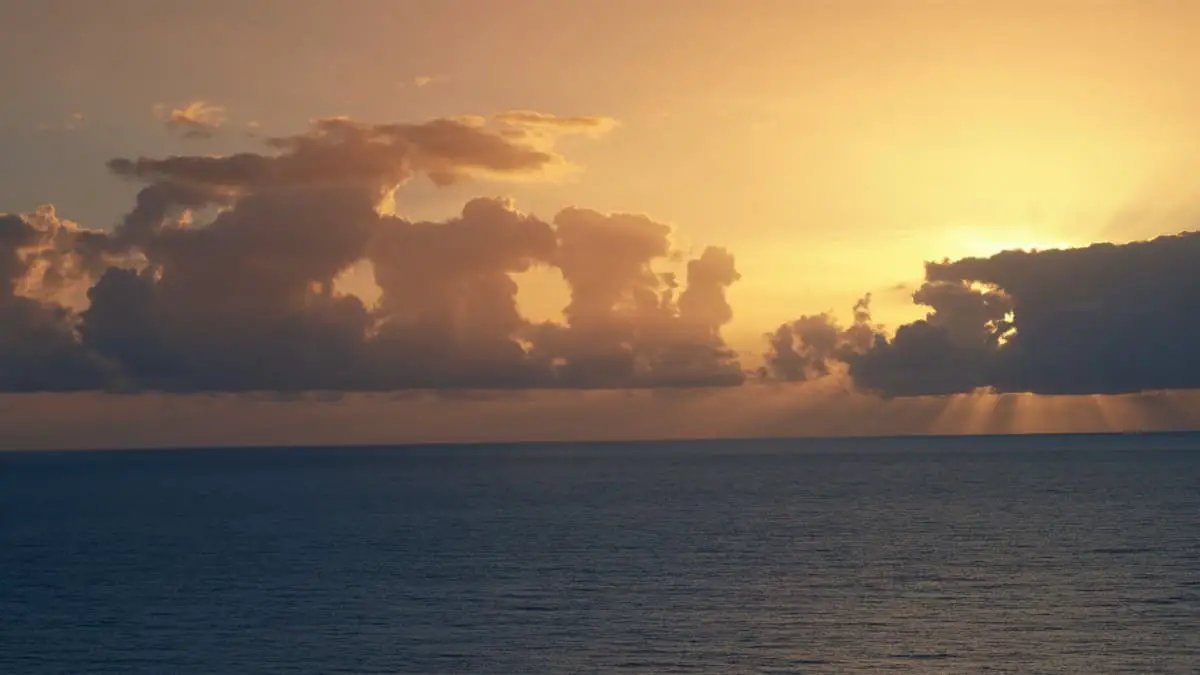
As an Amazon Associate, we earn from qualifying purchases. We may also earn commissions if you purchase products from other retailers after clicking on a link from our site.
Crossing the Pacific ocean is a challenging but exhilarating experience for any sailor, it is a must-do for circumnavigators and the path between the Americas and Australia. The Pacific Ocean can be rough at times and therefore it’s worth discussing whether or not a catamaran is suitable for this journey!
A Catamaran is an excellent vessel for crossing the Pacific Ocean. Catamarans make suitable vessels for long sea journeys as they are spacious, stable, and move at high speeds. Their stability makes them resist capsizing, the high speeds allow for outrunning storms and the interior space allows for enough crew and food.
In this article, I will go over the advantages of sailing across the Pacific on a catamaran. I will also discuss the potential length of time your voyage would take, the risks associated with cruising this area, and whether it’s feasible to do it alone.
Table of Contents
Can a Catamaran Cross the Pacific Ocean?
Catamarans are ideal for crossing the Pacific. The vessels are an ideal choice for any long journey, even crossing the Pacific, thanks to their size, large living area, high stability, and high speeds. The boat’s length, which should be at least 30 feet (9.1 m) long, is a significant consideration.
Crossing the ocean is no easy feat, even for the most experienced sailors. The good news is that a catamaran of a decent size, that is, above 35ft long, can handle the long journey.
You can make this journey on a 35 feet boat but preferably it should be done with something bigger than 40 feet.
If you want to better understand why catamaran size matters I suggest you check out my other article named best sized and catamaran for ocean sailing .
However, when considering crossing the ocean, you must be well-prepared for all the obstacles you might run into. Having an experienced crew on board is vital to a successful journey.
Prepare Well for Your Pacific Ocean Crossing
A lot goes into preparing for such a long journey. Planning ahead and doing research is necessary to ensure that you are ready for your trip across the ocean . If you have experienced sailor friends, you can always ask them to provide any tips they might have. There are also numerous helpful resources online that can aid you in getting prepared for crossing the Pacific.
When it comes to sailing across the ocean, you must be sure of your skillset as a sailor. Also, it would be quite helpful if you have a group of equally experienced sailors to help you along your journey.
When you prepare well and take all precautions necessary, crossing the Pacific Ocean will be an exhilarating experience and one that you will remember for a lifetime.
Choose the Right Vessel
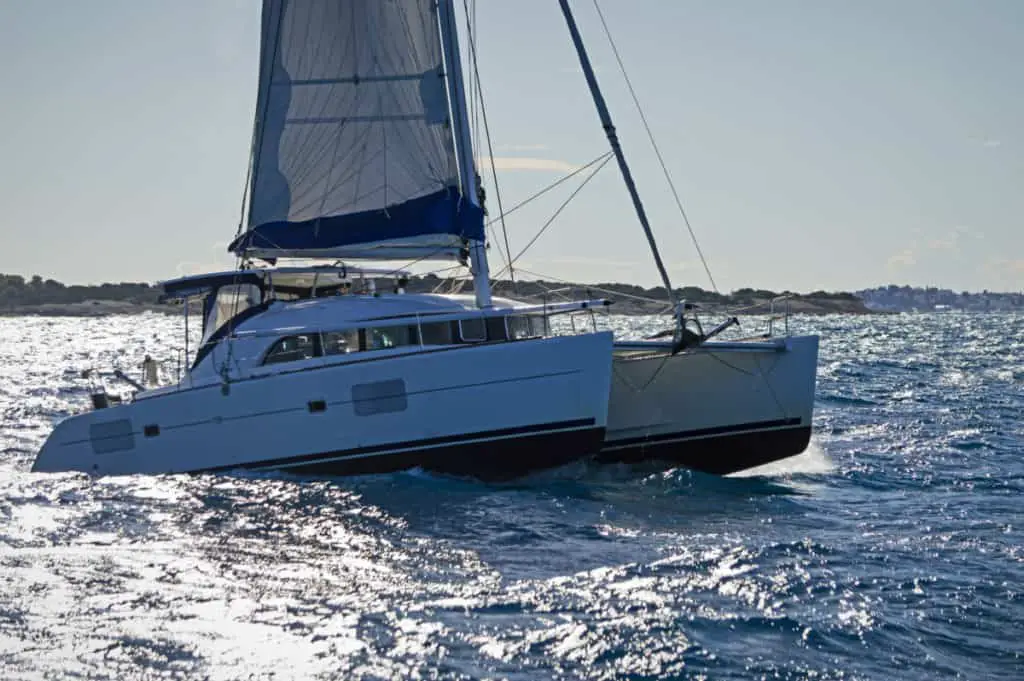
Choosing the right vessel for your journey is the first step in preparing for the journey. There are many great options to choose from, and a sailing catamaran is among the best choices. Many experienced sailors prefer sailing with a modern catamaran over other boats because of its comfort, stability, and high speed.
Larger catamarans have enough space to have a comfortable sail while not sacrificing performance. They are especially suitable for families that like to travel together. Large living spaces also provide excellent privacy if needed. This also allows enough room for a kitchen, making the cooking experience onboard more enjoyable.
With 40+ ft catamarans, there is enough space to fit several passengers and crew members.
Thanks to the dual hull design, catamarans are also much more stable than their monohull counterparts. This reduces the movement of the boat from waves and makes seasickness less likely, thus decreasing the risk of crew fatigue and sailor mistake.
The low drag of catamarans develops higher speeds, cutting down the time needed to reach your next destination. It will also increase the likelihood of running away from a storm or avoiding a squall. A faster boat, if only if you are not faster, will in the long run get you to your destination days ahead of time.
This can be the difference between sailing in horrible conditions or cruising into harbor on a sunny beautiful day.
Here’s a video of a passage between New Zealand and French Polynesia.
How Long Does It Take To Cross the Pacific on a Catamaran?
Crossing the Pacific on a catamaran takes between two weeks to more than a month, depending on a variety of factors. The beginning and ending points, the number of stops you make, wind and weather conditions, and the size and speed of your boat all contribute to the length of your journey.
There are numerous ways you can go about sailing across the Pacific. Depending on your starting point and destination, there are also several popular and widely-used routes available.
Every journey requires careful planning, and your Pacific journey will be no different. However, you have to be ready for some adjustments to your plans as you can’t predict everything that might happen on your journey.
Crossing The Pacific During The “Sailing Season”
There are certain times of the year when sailing across the Pacific is safest, such as during the so-called sailing season, or dry season.
This sailing season runs from May to October, when there is less chance of rain and cyclones.
When embarking on a journey across the Pacific Ocean, many people choose one of the following drop-off points: If you live on the West Coast of the United States, you can begin your journey near Seattle, at the US-Canada border of the Juan de Fuca Strait.
If you want to start in the south, go to Mexico, specifically Cabo San Lucas. The Panama Canal is the only way to get to the Pacific from the East Coast.
Plan Your Route Well
Whatever route and time of year you choose, the most important part of your preparation for the journey will be carefully planning your route. With the aid of modern technology, you can easily map out your ideal route, complete with stops at numerous islands scattered across the ocean. This will make your journey both interesting and enjoyable.
While you can estimate how long the journey will take, there is no way to predict precisely how much time you will spend crossing the Pacific. This is because there are far too many variables to consider when determining how long the trip will take. That’s why it is critical to keep an open mind, enjoy your journey, and not worry about exactly how long it will take you.
How Dangerous Is It To Sail Across the Pacific?
Sailing across the Pacific is one of the safer large ocean crossings you can do. Although, longer journeys come with a number of risks, including bad weather, accidents onboard, or worsening of any existing health issues. Most of these, though, may be mitigated with careful planning.
Every action we engage in has some level of danger associated with it. Some activities involve higher risks than others. Sailing over an ocean is a dangerous task, and many things can go wrong during your voyage. On the other hand, sailors are well aware of the level of risk they are taking on when venturing out onto the open seas.
Risks Associated With Sailing Across the Pacific
Most of the risks associated with sailing across the Pacific can be successfully overcome with proper expertise and thorough preparation.
Some factors, such as weather, are beyond your control; nevertheless, picking the appropriate time of year for your journey might help mitigate such dangers.
When traveling by car, navigating in bad weather conditions can be challenging. The risks that come with unfavorable weather conditions are increased exponentially at sea. Storms cause not just rain and wind but also waves and rough water conditions.
Health Issues
Another issue that you might encounter during your trip is related to any health issues or injuries of the crew or passengers on board. Most people are aware of their health-related concerns and are ready to manage them when sailing. However, health conditions can not always be predicted.
Numerous studies have been undertaken over the years concerning health issues that sailors may experience when living aboard the boat for extended periods of time.
The tight space on the boat, lack of exercise, poor nutrition, temperature fluctuations, and isolation from the outside world are all factors that put sailors at risk of developing numerous illnesses. According to one study, sailors on board are at a greater risk of dying from a myocardial infarction.
Risk of Injury
The risk of injuries is also high aboard. There are numerous tools and gear on a boat that could potentially be hazardous, especially for those who are not used to handling them. Additional factors that often cause injuries are related to sun exposure and lacerations from sharp objects.
No matter the weather or time of year, when you spend time in the open sea, your skin gets overly exposed to the sun and can get easily burnt or damaged. When spending a lot of time at sea, using sunscreen with a high Sun Protection Factor (SPF) is necessary to protect your skin from potential sun damage.
It’s a must to have a first aid medical kit on board in case of any injuries or illnesses that may happen to you or others on your boat. Additionally, knowledge about resuscitation and how to provide immediate medical assistance are essential skills to have for at least one of the people on board, if not for all.
Man Over Board (MOB) and Solo Sailing

Drowning is another potential concern when sailing across the ocean. It is fairly easy for a passenger or sailor to slip overboard by accident.
Current technologies and safety procedures make it possible (but incredibly hard usually) to quickly assist the individual and get them back on board.
However, there is still a substantial risk if the overboard mishap occurs in rough seas or at night. In most situations, however, drowning may be avoided by taking proper precautions.
When it comes to single-handed sailing, the dangers of drowning in the event of an overboard accident are substantially greater, as I will explain further below. Otherwise, drowning can be caused by other circumstances, such as injuries, boating accidents, or underlying health conditions that might render someone unconscious and cause them to fall overboard.
Ultimately, there’s nothing particularly worrisome about the Pacific ocean that cannot be applied to any other open seas. As such, if all safety precautions are taken before you set off on your journey, most of the associated risks can be easily mitigated.
Can You Sail Across the Pacific Alone (Shorthanded)?
While you can sail solo across the Pacific, taking such a long journey alone can be dangerous. For instance, you may undergo psychological and physical health issues, which a lack of sleep could exacerbate. And in case of an accident, the chance of death is also significantly higher.
Any seasoned sailor would advise against embarking on such a long solo boat trip without extensive experience. There are numerous reasons why sailing alone across the Pacific is not a good idea for everyone. The crossing includes both external challenges posed by the ocean and the psychological stress that you will experience.
Nothing can truly prepare you for what the open ocean has in store for you, even if you have years of experience taking short solo sailing trips.
However, the fact that many people strongly discourage solo ocean crossings does not mean that some sailors have not succeeded in such endeavors. This is an adventure of a lifetime!
The Hazards of Solo Ocean Crossing
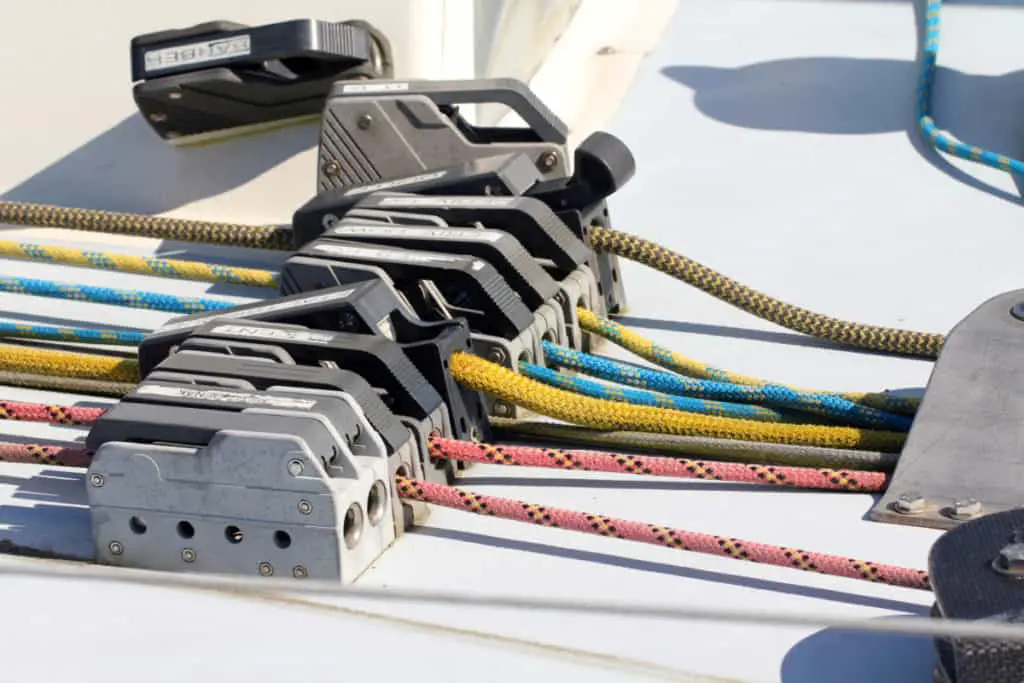
There are many hazards associated with sailing across the Pacific Ocean alone. These include:
Falling Overboard
Marine technologies have advanced significantly in recent years, allowing boats to be equipped with various devices that are aimed at preventing accidents. However, the risk is still quite high; in case you fall overboard and your catamaran is set on autopilot, there’s not much you can do to save yourself.
Most offshore boats are equipped with a tethering system that attaches the sailor to the boat with a rope, this means that in case the sailor falls overboard he or she will still be attached to the boat. This is not a good situation, but it’s way better than the boat sailing away from you.
Another challenge you’ll encounter when taking such a long solo journey will be a lack of sleep. Catamarans, as well as other types of boats, require great attention to make sure they are operating correctly and that you’re headed the right way whilst avoiding traffic. Therefore, you won’t be getting enough sleep as you work to ensure that everything on board is in order.
When sailing, at least one person should always be alert to see any potential hazards in advance. With single-handed sailing, this becomes impossible. There are many guides on how a person can survive with little sleep, such as taking short naps often, but doing that for days on end can be taxing for the body.
With the lack of sleep comes numerous complications even under normal circumstances. Considering that you’ll be all alone on the high seas adds another challenging aspect. With lack of sleep, your stress levels will rise, and you might lose focus along with lack of energy, eventually leading you to a potential disaster.
Potential Safety Risk
While single-handed sailing over a long distance, you are not only being a danger to yourself but also putting other sailors at risk. While modern technology has allowed boats to detect any ships coming their way, the risk of collision still remains if the solo sailor is sleeping or otherwise preoccupied.
Also, not all boats will be detected by this type of warning system, or AIS (automatic identification system) as it is called.
Final Thoughts
To sum up, it’s quite possible to cross the Pacific ocean on a Catamaran. However, sailing alone on such a long journey is tough even for the most experienced sailors.
Here are Some of My Favorite Catamaran Cruising Resources
Thank you for reading this article. I hope you found it helpful as you hopefully start your sailing adventures. Here are some resources that I use as a sailor that I hope you’ll also find helpful. These are affiliate links, so if you do decide to use any of them, I’ll earn a commission. But in all honesty, these are the exact things that I use and recommend to everyone, even my own family. Sailboats: If you’re looking for the best boat to suit your needs, I would recommend a catamaran. If you’re interested, I can show you the differences between catamarans and other types of sailboats .
Books: For getting started, I really like Cruising catamarans made easy . It is actually a textbook from the American sailing association; it is used to get a cruising catamaran certification. There are some other great books, and I have compiled a list of books about cruising catamarans that you will find useful.
Communication: Being out on adventures, whether it be sailing or climbing mountains, good communications are essential to being safe. I recommend two things Google fi (incredibly simple cellular data all over the world) and Garmin inreach mini (for text and voice in remote areas without cell coverage)
Sailing courses: Online sailing courses are great for beginners starting out their sailing career; it’s an efficient way of learning the basics of navigation, throttle controls, and maritime safety. I suggest starting with two free courses from NauticEd .
To see all my most up-to-date recommendations, check out this resource that I made for you!
Owner of CatamaranFreedom.com. A minimalist that has lived in a caravan in Sweden, 35ft Monohull in the Bahamas, and right now in his self-built Van. He just started the next adventure, to circumnavigate the world on a Catamaran!
Leave a Reply Cancel reply
Your email address will not be published. Required fields are marked *
Save my name and email in this browser for the next time I comment.
Recent Posts
Must-Have Boat Gear for Catamaran Sailors!
Sailing is probably the most gear-intensive activity I've ever done; there are so many decisions to be made about what gear to buy now, for tomorrow, and what to definitely never buy. The gear on...
6 Best Trailerable Trimarans For Bluewater and Coastal Sailing
Having a boat costs a lot of money, even when you are not using it, marina fees, etc. And once it is in the water most sailors never go very far from their "home marina" and sailing will be somewhat...
- BOAT OF THE YEAR
- Newsletters
- Sailboat Reviews
- Boating Safety
- Sails and Rigging
- Maintenance
- Sailing Totem
- Sailor & Galley
- Living Aboard
- Destinations
- Gear & Electronics
- Charter Resources
- Ultimate Boating Giveaway

Pacific Passage Planning
- By Alvah Simon
- Updated: July 29, 2019
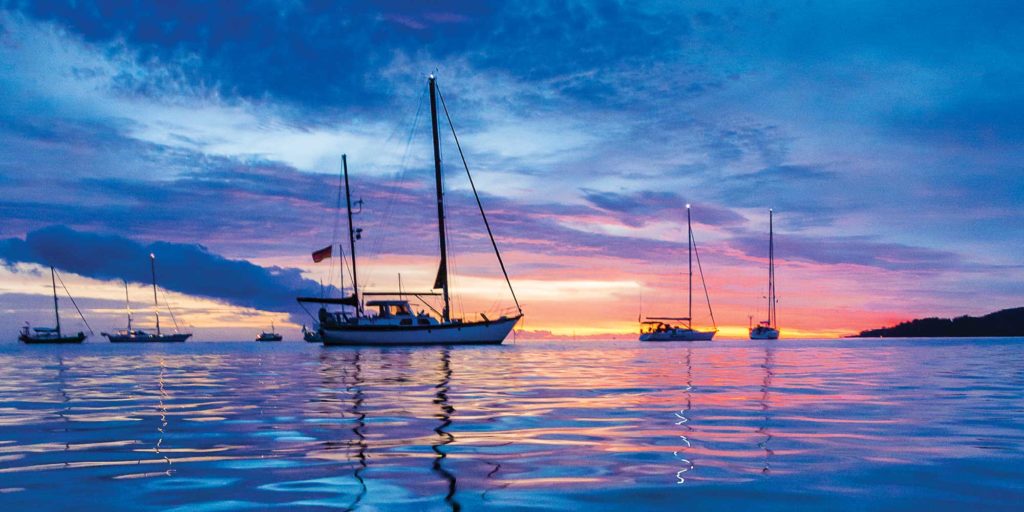
The definitions and delineations of a sea versus an ocean are complex, contested and best left to the learned geographers to debate. From a sailor’s point of view, excluding landlocked bodies of water, the rest of the brine is a contiguous path to glorious global adventure. Having said that, we do have our favorites. While the dreadful grind of the ice pack in the Far North and the towering graybeards of the Southern Ocean have their devotees, most sailing fantasies turn toward the seductive strum of the ukulele, the swaying palms and the white-sand beaches of the exotic South Pacific .
Ferdinand Magellan may have been a bit optimistic when he named a body of water that encompasses nearly one-third of Earth Mar Pacifico (peaceful ocean), for, like all oceans, it depends. The very size of the Pacific presents unique challenges, but so too do its strong currents, powerful storms, hazardous coral outcrops and remote low-lying islands.
Voyage Planning for Sailing the South Pacific
A successful Pacific passage will rely on meticulous planning , based on current information tempered with flexibility, because, by nature, cruising has it vagaries. But before one gets into the minutia of details, they should first step back and consider the bigger picture of sailing across the Pacific.
Is the vessel truly stem-to-stern, keel-to-masthead ready? Remember, a day’s work at the dock is worth a week’s under way. Is the dream and determination shared equally, or will the plan unravel with the first gale? Does a westward passage commit one to a circumnavigation, or are there strategic exit points? Does the voyage rely on a financial structure subject to change? Are you most comfortable as part of a rally, with a “buddy boat” or as a lone wolf?
Next is the paper chase. Gone are the whimsical days of letting the winds blow you where they may. The modern cruiser must be prepared in advance to face a host of legal requirements. First, ensure that every crewmember’s passport is as current as possible. Many countries will not issue visas to passports within six months of expiry. Next, list every country that you may wish to stop in and those in peripheral waters. Check the visa requirements carefully because the devil is in the details, especially if you have a multinational crew. Many countries require no visas if your stay is relatively short, or issue visas upon arrival. But some, such as Australia, will hit you with a hefty fine for showing up without one. Albeit increasingly expensive, cruising permits are normally obtainable upon arrival, but check the cruising websites and forums for current and accurate information. Make very high-resolution photocopies of your passports and ship’s papers. Bureaucrats love the pomp and splendor of shiny paper, and your precious original boat documents can stay safely on the vessel. If departing directly from U.S. waters, be aware that U.S. Customs does not normally issue a zarpe, or outbound clearance papers, yet these are required for entry into nearly any other nation. Download CBP Form 1300 and insist on a government stamp, any stamp. Be sure to have clear doctors’ prescriptions for every drug in the ship’s medical kit. What might be an over-the-counter medication in one country can be highly prohibited in another. Increasingly, foreign marinas demand third-party liability insurance. If you hope to further insure for damage and loss, check carefully the caveats relating to seasons and areas. If you plan to rent cars for touring, it is best to obtain an international driver’s license before departure.
Familiarize yourself with the basic elements that will shape your course and schedule — the direction and timing of the prevailing winds, significant currents, cyclone seasons, the positioning of the intertropical convergence zone and the South Pacific convergence zone. Ascertain if the year of passage has been deemed an El Niño or La Niña year because these phenomena can affect the above.
West Coast sailors may depart from as far north as the Strait of Juan de Fuca, near Seattle, or dally south to Cabo San Lucas, Mexico, while awaiting the passage season. For European and East Coast sailors, the Pacific launching point is obviously the Panama Canal. The details of a canal transit are complex enough to warrant an article of their own, but relevant here is do not assume a quick passage, because during peak periods there can be several weeks of delay. Also, build in time to enjoy both the San Blas Islands, on the Atlantic side, and the Las Perlas Islands, on the Pacific side.
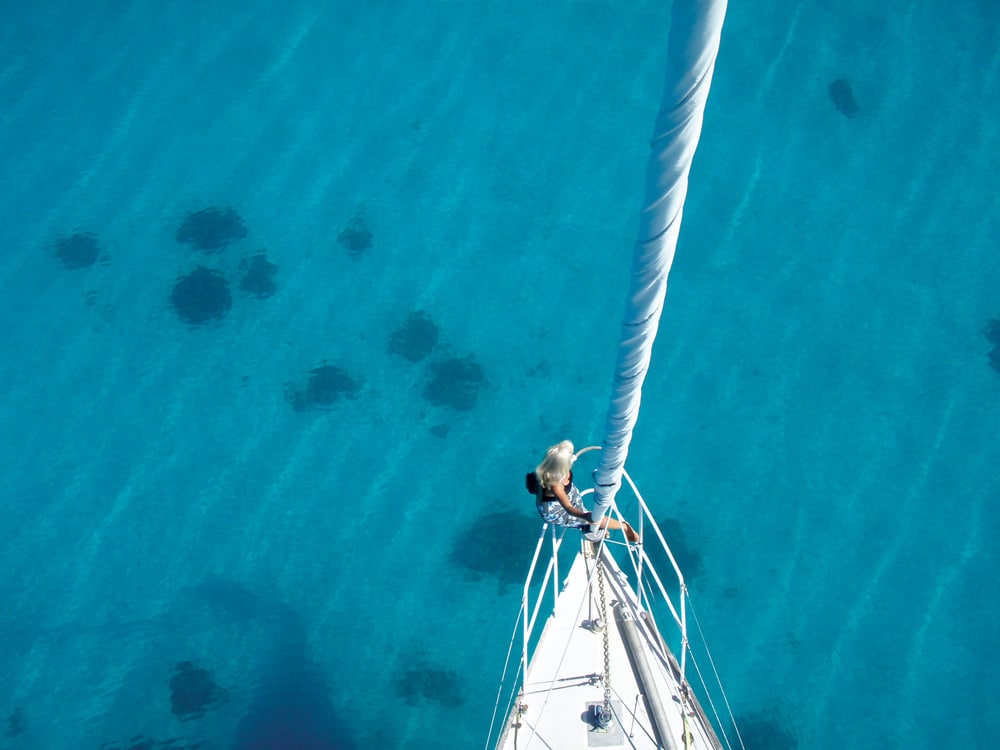
Pacific Sailing Routes
Although the official window for departures from Panama extends from February all the way to June, the trade winds tend to stabilize and strengthen as the year progresses. However, an early exit has many advantages. Leaving it until June allows only six months to transit up to 9,000 nautical miles before being forced to exit the cyclone belt at the western edge of the Pacific. This truncates the time to linger in favorite anchorages or tend to inevitable breakdowns and delays. Leaving as early as late January might technically put one out into the Pacific during the official cyclone season, but the statistical chances of a storm developing this far to the east are slim.
There are countless permutations of a westward passage, but the path dubbed the “Milk Run” is the most popular. Regardless of one’s plan for the western Pacific, this route passes by or through the Galápagos Islands , the Marquesas, Tuamotus and Society Islands (Tahiti).
The initial stage presents a challenge because the winds can be light and the currents contrary in the Gulf of Panama. It’s advisable to head slightly east of south when heading out of the Gulf; the western promontory is aptly named Punta Mala (Bad Point) due to its penchant for confused currents and squally weather.
Once well clear of the Gulf of Panama, fashion a southwestward course with a pronounced southern belly toward the Galápagos group. I once sailed a direct course for the Marquesas Islands that passed over the northern edge of the Galápagos. I paid for this foolishness by spinning in lazy circles for five excruciatingly long days. Given the early time of the year, I would have been better served by passing several degrees south of the island group. Because the intertropical convergence zone (better known as the doldrums) is widest in the eastern Pacific, it is best crossed at the least oblique angle reasonable.
On another Pacific passage, I chose to head south for Bahia de Caraquez in Ecuador. Not only was the cruise down the Ecuadorian coast fascinating, the passage to the Galápagos from Salinas provided steadier winds than had we departed directly from the canal.
The cost and conditions of a stay in the Galápagos are forever changing. As an admittedly stubborn form of protest, I sailed right by them on two different occasions. On the third, my wife, Diana, put her sea boots down and demanded we stop. Even with a limited stay and restricted access, we were treated to one of Earth’s most unique and fascinating natural habitats.
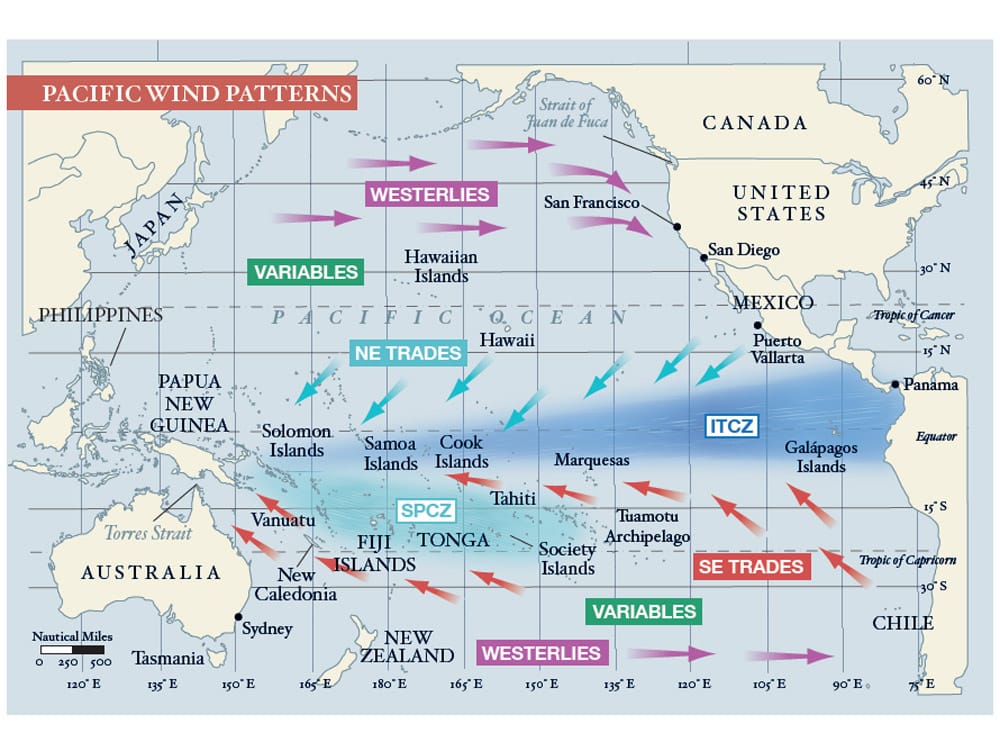
The 3,000-mile passage from the Galápagos to the Marquesas will probably be the longest of your sailing career. If you can focus on the journey instead of the destination, it might also be the most memorable. Many modern sailors tend to fill the Pacific void with a frenetic schedule of radio nets, emails and obsessive navigational updates. Others soak up the rare opportunity to commune deeply with nature, and experience a rare solitude and reaffirming self-reliance, which I believe to be the core virtues of bluewater sailing.
Counterintuitive to the landlubber but axiomatic to any old salt is that the rhumb line is often not the quickest route to a desired destination. Favorable winds mean speed, and the extra distance in search of them is usually well rewarded. When transiting from the Galápagos to the Marquesas, by first heading south-southwest down to 3 to 4 degrees south latitude, one should reach the upper limits of the southeast trade winds, albeit possibly sporadic at this point. But as you proceed west-southwest toward 6 degrees south latitude and 100 degrees west longitude, they should increase in both strength and consistency. As you straighten course toward your chosen port of entry in the Marquesas, you should begin experiencing your best noon-to-noon runs because you will still have a southerly component in the trades. This puts you on a broad reach, a point of sail most boats excel in. The farther west one heads, the more easterly the trades become until you are eventually running dead downwind. This tends to be a touch slower, with exacerbated rolling. Be sure to carry light-wind sails for the early portions of this journey, and equipment and sails suitable for downwind situations. That fortunate discrepancy you will notice between your speed on the log (i.e., through the water) versus the GPS speed (over the bottom) is compliments of the South Equatorial Current, which fortifies with the steadier trades.
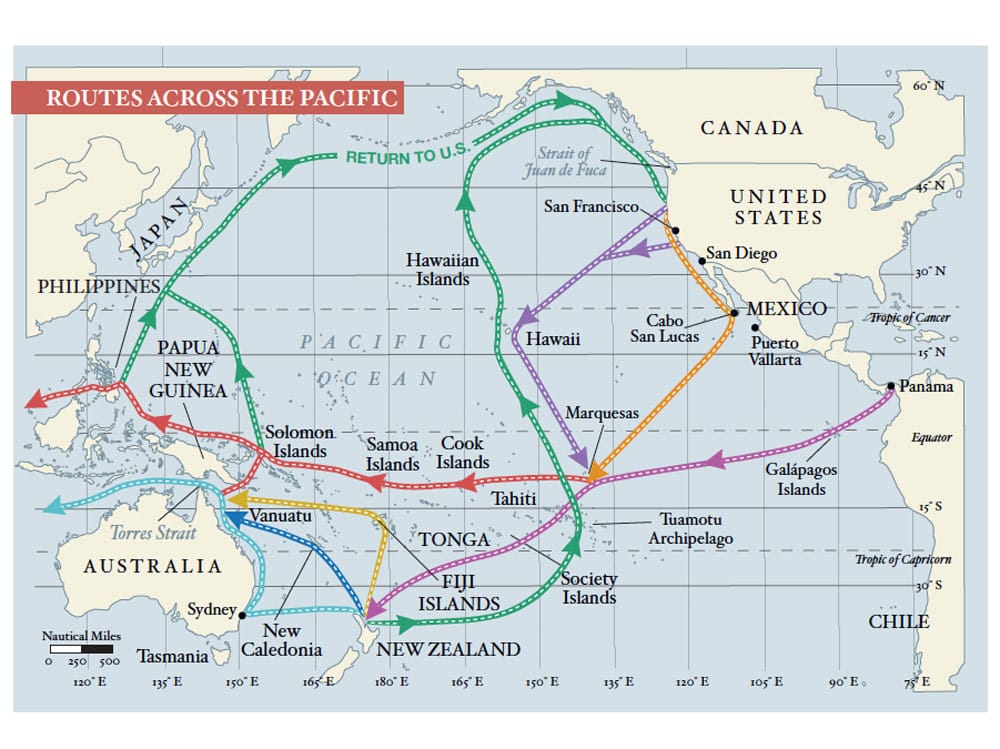
There is only one shoal area along the route, which is well-charted (8 degrees 5 minutes N and 139 degrees 35 minutes W), and the islands are high and easily sighted from afar. Entrances to the main ports are open and well-marked, thus safely approached, a blessing for a fatigued crew. What the Marquesas Islands might lack in terms of white-sand beaches and aqua lagoons is more than made up for with a geography so dramatic as to be somewhat foreboding — towering rock spires, dense jungle and precipitous waterfalls. These islands have been protected from rampant development by a crushing remoteness and therefore arguably remain the cultural heart of Polynesia.
Passages between the islands are mostly clear and well-charted, but potentially windy. The anchorages tend to be open roadsteads, so anti-roll tactics and equipment come in handy. Yachts can clear in at Hiva Oa, Ua Pou or Nuku Hiva. Those first stopping in Fatu Hiva have met with mixed results, ranging from spot fines to official clearance. Yachts are no longer required to rush to Tahiti to extend their initial 30-day visa. Thus, with 90 days in pocket, you can divide your time between the Marquesas, Tuamotus and Societies more evenly than in years past.
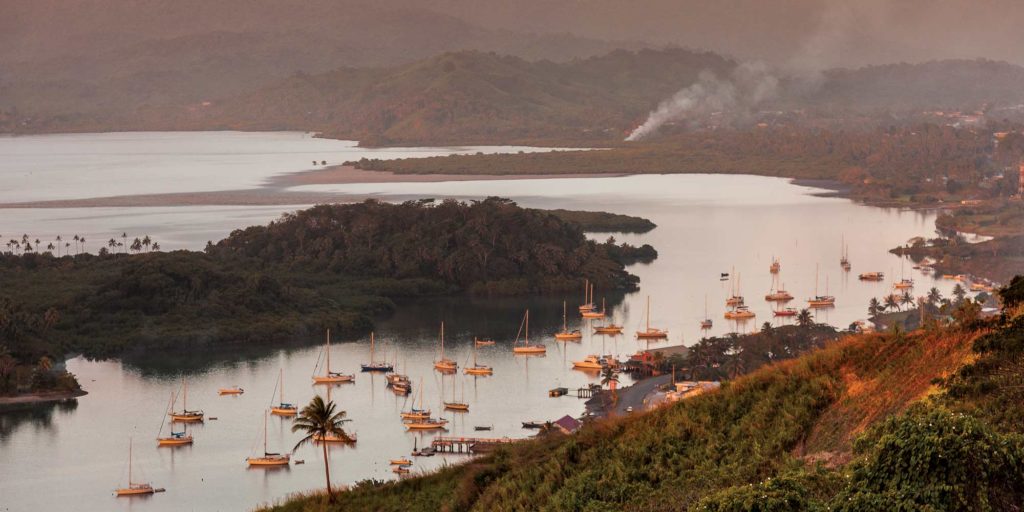
Encompassing an area larger than Western Europe, the Tuamotus are the longest chain of atolls in the world. Historically, they were known as the “dangerous archipelago,” and rightfully so due to a baffling maze of poorly charted reefs, low-lying islands and diabolically unpredictable currents. Even with the best of modern navigational equipment and weather forecasting, they demand the mariner’s absolute vigilance regarding watchkeeping, entry and exit from atoll passes, and anchoring techniques.
Those in a hurry to reach Tahiti tend to pass through the wider channels at the northern end of the chain, perhaps visiting Ahe, Manihi and the main center of Rangiroa. Others, with more time, make landfall far to the south and make their way up the chain via Makemo and the beautiful Fakarava Lagoon, enjoying a better angle off the wind on the short sail to Tahiti.
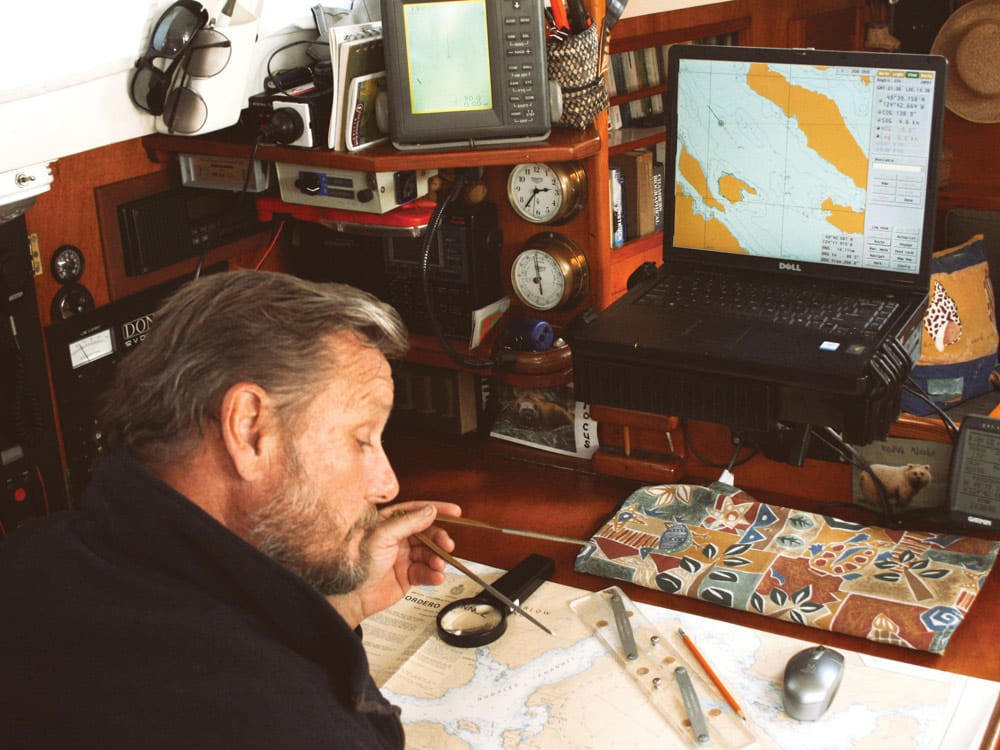
The Society Islands are divided into two groups: the Windwards, including Tahiti and Moorea, and the Leewards, with Huahine, Raiatea, Taha’a and, perhaps the most beautiful of them all, Bora Bora. They are all lush, high and ringed by azure seas. If early in the season, all are worth visiting. If time is short, be sure to at least attend the amazing group-dance competitions held in the buzzing capital of Papeete, celebrating Bastille Day on July 14.
North or South?
In Tahiti, the Milk Run divides into myriad possibilities. There is the northern route, for those planning to cross through the Torres Strait or into the Northern Hemisphere for the coming cyclone season, and the southern route, for those dropping south of the danger into New Zealand.
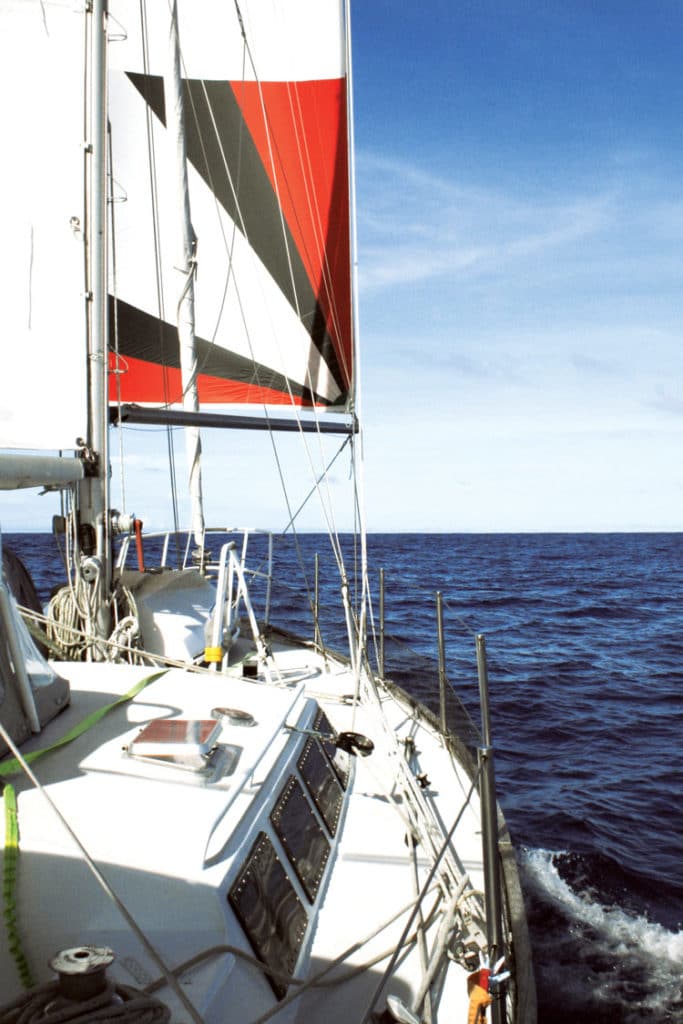
Although the majority of the South Pacific islands would remain unexplored, Tahiti is the earliest cutout for those needing to return to North America because its easterly location allows for a viable starboard tack through the southeast and northeast trades to Hawaii. The long but logical route from there is wheeling over the top of the North Pacific summer high and back south into U.S. West Coast waters.
While the land mass of the Cook Islands is a mere 100 square miles, its economic exclusion zone covers nearly 700,000 square miles of Pacific Ocean. One can only hope to draw a thin line through this scattered nation. For those on the southern route, the four- to five-day passage to Aitutaki or Rarotonga offers a predictable beam-to-broad reach right on the rhumb line.
En route to Niue lies one of two opportunities to experience the eeriness of anchoring in the middle of a featureless ocean (the other being the Minerva Reefs between Tonga and New Zealand). Beveridge Reef is a sunken atoll with not a skerrick of land awash at low tide, yet it offers anchorable depths within.
Niue is a raised coral atoll and geographically rare in the South Pacific. As anchoring depths are prohibitive, deep moorings are available. Keep in mind that it is an open roadstead vulnerable to dangerous swells. If the wind even hints at going west, as it occasionally does, get out immediately.
To break up the 1,200-nautical-mile haul to American Samoa from the Society Islands, the northern fleet usually takes a break in the remote and uninhabited atoll of Suwarrow, also known as Suvorov. The pass is challenging, as is the anchoring. But those who dare will be treated to one of the wildest places left on this planet.
From this point west, both the northern and southern fleet enter into the South Pacific convergence zone, a dangling arm of the intertropical convergence zone that extends from the Solomon Islands in an east-southeast direction. The South Pacific convergence zone drifts with some seasonal predictability (more to the north from December to May and the south from June to November), but is also influenced by larger weather anomalies. It tends to shift to the northeast in El Niño years and southwest in the La Niña phase. Generally, it is an area of enhanced convection resulting in a frustrating mix of cloud cover, line squalls and calms.
The list of interesting stops from here west includes Tonga, Wallis and Futuna, Fiji, Vanuatu, New Caledonia, Tuvalu, Solomon Islands and Papua New Guinea. Nevertheless, those planning to sail directly through Torres Strait into the Indian Ocean cannot afford to dally. They should be through the Torres by late August or early September in order to cross the entire Indian Ocean into South Africa before the cyclone season begins sometime in late November. A popular alternative is to pass south to a good cyclone hole on the Australian coast, such as Cairns or Port Douglas, and backtrack up to the Torres Strait at the beginning of the next safe season.
Keep in mind that an east-to-west circumnavigation does not demand a route through the Torres. I once circumnavigated by passing north of Papua New Guinea, avoiding the Southern Hemisphere cyclone season, taking in Palau, the Philippines, and Borneo before dropping back into the Southern Hemisphere for the Indian Ocean passage to southern Africa. Any destination north of 10 degrees south latitude will keep you out of harm’s way, albeit without the steady assist of those lovely trade winds.
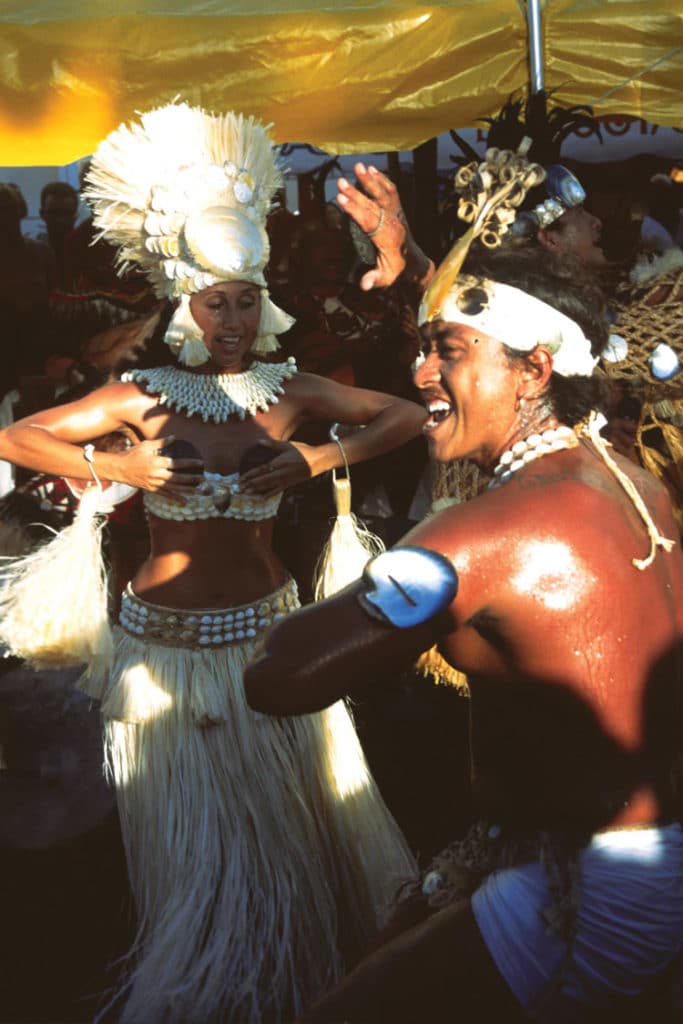
Those on the southern route can linger through Tonga or Fiji until well into November and still safely make New Zealand shores before any tropical depressions threaten. Most cruisers heading for New Zealand do not venture as far west as Vanuatu or New Caledonia on the assumption that they can easily fetch them on their way north the following season.
Unanimous acclaim for the beauty of the northern Tongan groups of Niua, Vava‘u and Ha‘apai makes some time here mandatory, which harks back to my original advice to head out of Panama as early as safely possible. The southern contingent usually drifts south toward Nuku‘alofa, the capital, until it likes the long-range forecast for the passage to New Zealand. Many plan to hole up in Minerva Reef, getting a head start on the 1,100 miles to New Zealand, and depart there with the absolute latest weather predictions.
The reputation of this leg has more bark than bite, but it cannot be denied that tropical weather events drifting down from the Coral Sea and cold fronts coming up from the Southern Ocean have dramatic potential. One can expect winds from nearly every direction, starting with southeast trades on departure and potentially deep lows with strong southwesterlies shifting to northwesterlies when approaching New Zealand. Thus, the usual advice is to fall off the southeast trades and make some westing in anticipation of that southwest-to-northwest change. Not to be a contrarian, but I have made this passage more than a half-dozen times and believe it is better to hold to the east as far as wind and waves allow because if that southwest change does not occur, you might find yourself on the wrong side of North Cape, New Zealand, with contrary winds and confused currents. Although Norfolk Island is not a fully protected anchorage, many vessels that find themselves west of the rhumb line with foul forecasts to the south will shelter here until conditions improve.
It’s possible, albeit tedious, to return to North America from New Zealand. Vessels head out to the east from as far south as Tauranga hoping to catch the northerly limits of the westerlies until they fetch the longitude of the Austral Islands, then turn north for Tahiti. From there, they follow the route as previously described. From the outset of their voyage, some have planned to sell their yacht in New Zealand or Australia rather than carry on with a circumnavigation or a very lengthy sail back to the United States, especially if they are East Coast residents. Import duties, brokerage costs and currency exchange rates must be factored into this strategy. Is it heresy to suggest that another option is to ship the vessel back home? The initial estimates might seem staggering, but once compared to the escalating marina and maintenance costs, and the many windward months and miles home, the horror subsides.
Whatever your plan from here, through a combination of wind and will, you have done it. You, your crew and your splendid craft have spanned the mightiest body of water on Earth. You have immersed yourself in millions of square miles of salty solitude and self-reliance. You have absorbed the exotic cultures of Central Americans, Polynesians, Micronesians and Melanesians. And now, as only a seasoned mariner can, you truly understand why they call it the Big Blue.
Contributing editor, Alvah Simon, and his wife, Diana, are presently sailing New Zealand waters on their cutter Roger Henry, with occasional voyages to the South Pacific islands.
South Pacific At A Glance
- Dry Season: May-October
- Wet Season: November-April
- Cyclone Season: November-April. Active
- Cyclone Area: south of 10° S; west of 140° W
- Distance: Panama to Australia — 8,000 nautical miles
- Cultural Areas: Polynesia, Micronesia, Melanesia, Australia/New Zealand
References:
- World Cruising Routes by Jimmy Cornell
- noonsite.com (Virtually everything you will need to know on a current basis will be found on this comprehensive website.)
- Atlas of Pilot Charts — South Pacific, DMA/NOAA
- The Pacific Crossing Guide by Kitty Van Hagen
- Charlie’s Charts of Polynesia by Charles and Margo Wood
- Landfalls of Paradise by Earl Hinz and Jim Howard
- South Pacific Cruising by David Thatcher
- South Pacific Anchorag es by Warwick Clay
- Rocket Guide to Vanuatu & New Caledonia
- Solomon Island Cruising Guide by Dirk Sieling
- New Zealand Coastal Cruising Handbook by Royal Akarana Yacht Club
- Lonely Planet South Pacific Travel Guide
Selected SSB/Ham WX Nets:
- Southbound Evening Net: 6516 kHz at 0100 UTC
- Panama Pacific Net: 8143 kHz at 1400 UTC
- Pacific Maritime Mobile: 21.412 MHz at
- 2100-2400 UTC
- Pacific Magellan: 8173 kHz at 1730 UTC
- Pacific Seafarers: 14300 kHz at 0300 UTC
- Namba/Sheila Net: 8101 kHz at UTC plus 11 hours
- Gulf Harbor Radio: 8116 kHz at 0715 local New Zealand time
- (There is a host of smaller and temporary VHF and SSB nets throughout the Pacific.)
- More: Affiliate , Destinations , How To , offshore , Pacific , passage making
- More How To

Grease the Wheels of Your Boat: A Guide to Proper Lubrication

A Bowsprit Reborn: A DIY Renovation Story

Rigging Redo: Our Switch to Synthetic

Top Tools for Sailboat Cruising: Must-Have Gear for 2024

Galápagos: A Paradise Worth the Paperwork

Around Alone

- Digital Edition
- Customer Service
- Privacy Policy
- Terms of Use
- Email Newsletters
- Cruising World
- Sailing World
- Salt Water Sportsman
- Sport Fishing
- Wakeboarding
How Long Does It Take to Sail Across The Pacific?
Doing a pacific crossing on a monohull or catamaran is one experience you’ll cherish for years, but one that requires a ton of prior planning.
Crossing the Pacific – Sail Times
With more than 8,000 nautical miles to sail, it takes 2.5 to 4 weeks to make the longest leg of a Pacific crossing from Galapagos Islands to The Marquesas. However, most cruisers take 3 to 6 months, or even up to 12 months, to do the entire ‘Coconut Milk Run’ from Panama to Australia, by stopping into many atolls, islands and countries along the way.

Fortunately, this long crossing typically has favourable currents and strong tradewinds, allowing both a fast and comfortable passage with many cruisers referring this to being relatively easy sailing. Mild swell, predictable and clean winds and with next to no squalls, it’s a trip that’s well within your means, and yes, even if it’s your first large crossing.
That is – provided you do some strong planning, good provisioning and have more than 2 crew members. We certainly wouldn’t recommend an Atlantic crossing for a couple unless you’ve got some serious sea miles under your belt, otherwise, you’ll arrive into French Polynesia completely and utterly exhausted.
In this guide, we’ll help you better plan the trip so you can have a safe and comfortable voyage, and you’ll see why the South Pacific especially is one of the best cruising grounds out there.
West-Bound vs East-Bound
In many cases, it’s far better to head east-bound (towards Australia) as opposed to sailing towards the Panama Canal. This is because you’ll be sailing upwind with both tides and wind working against the boat.
Not only will the ride be more uncomfortable, but you’ll be putting more stress and strain on your boat at the same time. Many cruisers like us are out there to have fun and aren’t fond of an unpleasant crossing.
Length of Voyage
As we hinted at the start, you shouldn’t focus on the length of the crossing but plan for an entire year (or 3!) to do a Pacific crossing. This is because of the epic islands, unique cultures, incredible anchorages and stunning mounts (hello Marquesas!) that you’ll find along the way.
Unlike the Mediterranean, there are thousands of protected anchorages along the way paired with many available buoys (often times free) to protect the sensitive coral reefs. When you’re cruising, who’s in a rush? Especially when it’s the trip of a lifetime for many aspiring sailors.
Route Planning
A truly first-world problem is choosing which route you’d want to take on your first Pacific crossing, and there is no one-route-fits-all approach here. It really comes down to your boat type, crew numbers, vessel weight, time of year and current experience.
We would highly recommend stopping into the Galapagos Islands and stay for 2 to 3 weeks. Quarantine here is quite strict so you’ll have to consume or dispose of any food before entering port while ensuring you arrive on a spotless hull.
A drawback towards any Pacific crossing is experiencing the doldrums. This challenge is mostly felt after leaving the Galapagos Islands en route to French Polynesia, but then again…where else would you rather be?
For the following islands, their order is based on heading eastwards on a Pacific Crossing.
French Polynesia
If time permits, we would recommend 1 to 2 months in French Polynesia if you really want to experience the culture shock and the incredible hospitality. This country is the epitome of world cruising and ‘living the dream’ with the many atolls and empty beaches where few tourists ever visit.
For those of you rushing the trip, then you can’t leave without stopping into Taumotus and The Marquesas for their incredible mountains and lush rainforests. As an added bonus, the frequent rainfalls means that you’ll be able to get that salt off your deck too!
If you’re anything like us, Tahiti has been at the top of your bucket list for years. It sits almost smack-bang in the middle of Australia and the United States meaning it’s both difficult and expensive for every day tourists to explore. The benefit(s) of owning a sailing vessel after all, right?
Tahiti is a part of the Society Islands and is the most popular island for cruisers. It’s certainly worth a stopover to rest, recover and restock your boat with fresh provisions.
One of the most beautiful things about Tonga is the short hops between its 3 main anchorages. This makes for a welcome reprieve after the Pacific crossing, paired with incredible hospitality.
Unfortunately, this is also where you’ll start seeing commercial tourism at play given the daily flights between Tonga and Australia. So if you’re missing modern civilization, just remember “Things get normal again from Tonga onwards”
Things really start to get normal from Fiji onwards with resorts, hotels and restaurants never too far away from Suva. Fortunately, Fiji is a huge cruising ground and you could spend several months here without seeing the whole lot.
While snorkeling, fishing and diving can be found in many Pacific islands, Fiji is also where you’ll find some epic places to go surfing, kite boarding and even pick up some half-decent WIFI to catch up on social media back home. Like we said….you’re almost back to normality here.
Vanuatu isn’t as busy as Fiji (fortunately!) and makes for a great stopover before you do your final stretch of sailing across the pacific. We fell in love with the amazing scenery both above and below the waterline.
The local people are warm and friendly while the local festivals can’t to be missed. Some say it’s the happiest country in the world, and we certainly couldn’t disagree! It’s at this point that you’ll start to feel some angst as the end of your trip is looming.
Finishing a Pacific Crossing in Australia or New Zealand?
For many who are finishing off their Pacific crossing, it’s hard to know whether to make a bee-line for Australia and enter in Brisbane, Coffs Harbour or Sydney, or make a diversion to Auckland. This depends on what time of year you’re making the Pacific crossing.
In late autumn through to mid Summer, it’s a perfect time to check into Auckland and explore the incredible cruising grounds of New Zealand’s North Island. However, the region is very cold in the winter months paired with less predictable weather systems making a leap to Australia more challenging for a novice sailor.
So in short, aim for Auckland if you can make it, otherwise sail direct to Australia’s east coast. Sydney to Brisbane can be cruised year-round with no cyclone seasons making a perfect base in which to explore, and later head for Auckland as summer approaches once again.

Sailing The Pacific In A Catamaran – Tips!

Sailing the Pacific can be a dream to many. It can also be a wonderful experience to explore new routes, tackle varying weather conditions, and cherish moments for a lifetime.
Sailing the Pacific in a catamaran of 30-50 feet is feasible, and it can take around eight weeks to sail it completely. Sailing offshore can be dangerous, so consider the West Coast route for a great experience.
If you are still planning an itinerary to sail the entire Pacific Ocean, this article can offer extensive insights to help you plan better and make your trip more memorable.
Pacific Sailing Routes
There are two sailing routes across the Pacific – East to West and West to East. Taking the route from East to West via Panama and The Galapagos is ideal.
Let’s look into these routes in more detail before you make your decision on which one to take.
Coconut Milk Run
Most sailors prefer taking the coconut milk run, which is the route from East to West, as the weather conditions are convenient and the route is comparatively shorter.
The sailing begins from Panama and moves via French Polynesia. Perhaps, if you prefer a halt in the mid, you can visit the Galapagos Islands and rest for some time. It takes about 6-8 weeks to sail across the Pacific Ocean via this route. Perhaps, you can customize the stop points depending on the starting point. Some even go beyond the Pacific and sail the Caribbean for a unique experience.
West to East
Most sailors don’t prefer taking the route from West to East due to the upwind that demands strong capability of the crew and other contingency preparations. The direct route is the fastest, but the winds are high. On the other hand, the Northern Route is filled with several small passages and can be the most favorite for adventure lovers. Do not attempt this route if you do not have a well-backed crew. Another route called the roaring forties takes about ten weeks and has several downwind spots.
You could take a catamaran of 30 to 50 feet in length on both routes, but you may need additional helpers if you due to the demand of this trip length.
Do you have ample time to spend on your sail? In that case, you can set the United States as your starting route and go via Hawaii, Fiji, Polynesia, and New Zealand if you want a huge trip.
Can A Catamaran Cross The Pacific Ocean?
A catamaran of 30-50 feet in length can cross the Pacific Ocean smoothly. Remember to stock up with supplies if you are taking the West to East route due to its length. The East to West route is filled with scenic views and is the most favorable choice.
Catamarans are ideal for crossing oceans, including the Pacific due to their size and speed. Some experienced sailors choose monohulls to sail across the Pacific instead of catamarans, but the catamaran is safer and more comfortable to spend your vacation on. Everyone is entitled to their own opinion though.
Here are some more reasons to cross the Pacific Ocean with a catamaran over other sailboats.
- Cruising catamarans are perfect for oceans due to the positive buoyancy material used.
- Catamarans are also resistant to damage and can withstand wave crashes. Do not go with recreational cats when you sail across the ocean.
- Cruising catamarans are ideal for rough weather conditions as these contain enclosed cockpit spaces that keep the sailors safer.
- It is harder for a rogue wave to push a catamaran off course. Irrespective of the route you choose, you can go with a catamaran.
- Crews have found it extremely comfortable to balance on a catamaran.
- Knockdowns cannot hamper the catamaran because of the even weight allocation and the natural roll resistance in its design.
Want to get a glimpse of the sailing experience across the Pacific? You should watch the video below:
As you can see from the video it can be rough at some times and safety is one thing you always need to consider before leaving port.
Dangers Of Sailing The South Pacific
Sailing the South Pacific is the safest during the summer. Otherwise, it would be best if you had a balanced crew and a perfect itinerary to handle all situations.
When you sail the Pacific along the United States and Canada, you are less likely to see upwind during summer. However, things can worsen during winter.
Here’s a word of caution: Do not sail offshore if you do not have an expert team of sailors.
Although fatalities are uncommon, it is better to take precautions as you travel on a catamaran. Typhoons are claimed to be the most dangerous hazard in the pacific and you need to be cautious when you sail across the Pacific. While these are always common, the speed and intensity can put everyone at high risk for injury or falling overboard.
If you have inexperienced sailors, you must know that the Pacific is not simple sailing. Heavy weather is anticipated from November to April. You need several experienced sailors to tackle rough weather conditions and the seasickness of passengers can cause issues when sailing.
There are other risks as well, including passengers overboard, rough weather, catamaran problems, and navigation errors. Sailing amidst rough weather conditions is common for sailors to get confused or lose access to navigation. In such cases, you need to make use of communication models like tracking devices and search and rescue services.
Here are a few precautions to keep in mind before you begin sailing across the Pacific:
- Evaluate your crew’s stability and health – Check if you are prepared to handle sudden medical emergencies of your crew.
- Make a note of contacts to search and rescue services – This will be helpful if you lose navigation or are stuck in the middle of the ocean.
- Evaluate the strengths and weaknesses of your sailors – You do not necessarily need 10 highly skilled sailors. However, having a handful is sufficient to handle the issues that may come up.
- Monitor weather conditions and note contingency plans – It is recommended to plan your vacation during May-July. Otherwise, weather conditions can get rough and pose several emergencies.
How Long Does It Take To Cross The Pacific By Catamaran?
It takes an average of 7-10 weeks to cross the Pacific by catamaran. The duration depends on the size of the vessel, the number of passengers, route, itinerary, and weather conditions.
Some prefer having several stopping points to relax and take a break before continuing the cruise. A rough estimate of the duration is feasible. However, identifying the accurate duration is difficult since several variables exist in the ocean.
Here are some tips to obtain a better grip on the duration:
– Choose the perfect route. The East to West route is the shortest of all.
– Keep modern technologies handy so you do not waste time finding solutions to your emergencies. I’d recommend installing radar systems to avoid collisions and plan your itinerary better.
– Plan the itinerary before leaving port. Perhaps, you can make adjustments along the way, but that should not affect the duration on a large scale.
– The size of the catamaran is also influenced by the number of passengers and other baggage.
How Big Of A Sailboat Do I Need To Cross The Pacific?
A sailboat at a minimum of 30 feet is required to cross the Pacific and handle rough seas. However, if you have a sailboat of 40 ft in length, it is perfect for tackling weather, and storage needs, and also helps improve comfort.
There is also the option to rent a sailboat to cross the Pacific. Ensure you have a complete understanding of how this boat works. You do not want to be caught out in the middle of rough weather not knowing how to correct a boat’s issue.
Smaller sailboats do not support rough weather conditions. Further, your comfort is at stake when you choose smaller sizes. Even if you are traveling solo, the size of the vessel matters a lot.
Tips For Better Pacific Sailing
Sailing across the Pacific is likely to throw unexpected situations at travelers. Based on the experiences of various sailors, I have come up with some handy tips to improvise and get the best out of your sailing experience across the Pacific.
- Maintain a crew of at least three experienced sailors. This crew needs to take shifts in sailing the catamaran and watching the route. Even when one of them falls sick, the other two are available.
- Keep a navigation chart handy. It is better to have multiple copies and also share them with your passengers, so all are well-equipped and informed about the itinerary.
- Perform an extensive evaluation of the catamaran. Do not randomly choose a catamaran. Remember to inspect the boat and rate its current health. Keep spare parts on board for certain situations. It is also equally important to have experienced sailors who can repair the boat and fix things when required.
- Check with safety laws and ensure that your catamaran complies with all of them before you start your journey across the Pacific.
These have always helped me sail better and more confidently.
Final Thoughts
Sailing across the Pacific is a must-have experience in life, but it also comes with its drawbacks. Sailing at the right time (May – July) in a cruising catamaran of at least 30 feet in length with a proper plan will make the experience fruitful and interesting.
Remember not to overload your catamaran with people or items. Likewise, choose the route that is convenient to you. Cruising on a catamaran is the perfect way to enjoy your journey!
Boatlifehq owner and author/editor of this article.
Recent Posts
How to Repair a Sailboat Hull: Step-by-Step Guide
Maintaining your sailboat's hull is crucial for ensuring its longevity and performance on the water. Hull damage can occur due to various reasons, such as collisions, grounding, or general wear and...
10 Steps For Anchoring Your Sailboat
Anchoring a sailboat is a fundamental skill every sailor must master. Proper anchoring ensures your boat remains secure, preventing it from drifting and potentially causing damage. Whether you're...

Are Catamarans Safe For Ocean Crossing?

Last Updated by
Daniel Wade
June 15, 2022
Catamarans aren't the most common ocean-crossing sailboats, but they're surprisingly safe and capable offshore.
Catamarans are safe for ocean crossings. In fact, catamarans are often much safer than similarly-sized monohulls offshore. Safety comes from increased motion comfort, great stability, speed, and excess buoyancy due to lack of ballast.
In this article, we’ll examine if catamarans are safe (or safer) than monohulls for offshore cruising and ocean passages. We’ll also examine the benefits of cruising catamaran design, along with how these vessels handle in different offshore conditions.
We gathered the information used in this article from offshore sailing guides and reputable catamaran experts. We also examined design guidelines for offshore cruising boats, including head-to-head tests done between catamarans and other vessels.
Table of contents
Safety of Bluewater Catamarans
Cruising catamarans that are capable of bluewater sailing are some of the safest vessels on the water. In fact, they're often preferred for ocean crossing due to their miraculous speeds and excellent rough-water handling qualities.
Catamarans are uniquely equipped for safe and comfortable offshore sailing. They're not subject to the traditional limitations of hull speed, and they have a mild planing effect which reduces drag and the effects of rough seas.
Safest Catamaran Design for Crossing an Ocean
The safest ocean-crossing category is cruising catamarans, as these vessels include design elements and safety features that aren't found in recreational racing catamarans. An example of this is additional positive buoyancy material and watertight hatches.
Cruising catamarans have high-strength cockpit windows, which are designed to resist damage if a wave crashes on them. They also have redundant systems such as bilge pumps, navigation lights, and radios—which are all essential in an offshore voyage.
In fact, cruising cats are so safe that they're often recommended by expert sailors to more novice individuals. They aren't necessarily easier to sail, but they can handle rough weather safely and with better stability.
This keeps the crew dry and rational while the boat handles much of the ocean's beating all on its own.
Is it Safe to Sail a Catamaran During the Winter?
Catamarans can actually be safer to sail in winter weather conditions than monohulls. This is because cruising catboats almost always have enclosed cockpit spaces that are completely shielded from the elements. This is particularly helpful during the winter, but it's also a great feature in the tropical rainy season.
Catamaran crews can usually pilot their vessels from inside or behind these enclosed cockpits, keeping them warm and dry for as long as possible.
Additionally, given the premium nature of cruising catamarans, many of these vessels have automated winches and sails, allowing complete control from the interior cockpit.
How do Catamarans Handle Rough Weather?
Catamarans handle rough weather well, especially larger vessels with more displacement. But unlike monohull sailboats, draft and displacement aren't the most critical factors when evaluating foul-weather safety.
Catamarans are more difficult to swamp than monohulls. This is because they create a channel between their hulls that acts as a pressure relief valve, thus decreasing the likelihood of a rogue wave pushing the vessel under or knocking it over.
Catamarans are famous for their ability to weather high winds and chop. An equal-sized monohull may be just as strong and seaworthy, but the crew certainly wouldn't be praising its easy-riding qualities after a strong storm.
Catamaran captains are sometimes guilty of underestimating the danger or intensity of storms because a storm that beats the confidence out of a monohull crew may not even spill the coffee off the galley table in a catamaran.
Catamaran Buoyancy
Catamarans also have design elements that make them difficult—or nearly impossible—to sink. Or, to sink completely anyway. It's all about buoyancy, and catamarans have tons of it.
Monohull sailboats can handle well offshore, provided they have a low enough center of gravity and enough displacement to stay upright in violent gusts and large waves. Usually, monohull designers achieve this by working in an extremely heavy and deep ballasted keel.
In other words, offshore monohulls sit artificially low in the water due to added ballast for stability, both inside the cabin and deep in the keel. This is great until something starts to throw off-balance, like a bunch of water in the cabin.
Catamarans don't sit very low in the water because they're much more buoyant than monohulls and carry no large keels or ballast.
On their own, catamaran side hulls would probably roll over due to their lack of low ballast. But when strung together, they balance each other out and keep the hull far out of the water.
Catamarans don't often sink because they're simply too buoyant. They use their width and dual hulls to make up for the lack of ballast.
Plus, catamaran builders sometimes add additional positively buoyant material such as foam, to the point where sinking an intact vessel would be utterly impossible.
Are Catamarans Strong Enough for Ocean Sailing?
All production bluewater catamarans are extremely rigid and structurally sound. Catamarans make ocean journeys all the time and suffer tremendous stresses, which monohulls never experience. As a result, they're built using stronger materials and reinforced in all necessary areas.
Do Catamarans Break in Half?
It seems easy enough to believe—a catamaran hits a funny wave and breaks in half. After all, catamarans are only held together by a thin strip of fiberglass, right? Wrong—catamaran design is very robust, and all production catamarans are thoughtfully designed and strong.
Apart from the odd story in a sailing magazine, catamarans rarely just break in half. There have been some cases of it happening, but only due to extreme conditions, specific design flaws, or shoddy amateur construction.
Catamarans hulls break off far less often than regular monohulls sink—often in much less hazardous conditions than the few catamarans that did break in this way. So no, you don't have to worry about a production catamaran breaking in half while on the ocean.
Catamaran Comfort and Safety
Comfort can actually be a safety benefit on the open ocean, especially when sailing with a limited crew. Catamarans are known for their stability and increased motion comfort, which can improve the overall health and ability of the crew.
Think about it this way. A seasick and exhausted crew won't be able to deal with navigation or emergencies as efficiently and safely as a well-fed and well-rested crew. This is one of the indirect benefits that offshore catamarans have above most traditional monohull designs.
Catamaran Roll Safety
What happens if a catamaran suffers a knockdown? Usually, nothing good—catamarans can't self-right after a knockdown, unlike some monohulls with a low center of gravity. You're much more likely to have a knockdown or nail-biting roll on a monohull than a catamaran.
That said, catamarans don't suffer knockdowns nearly as easily as similarly-sized monohulls. This is because catamarans distribute their weight widely, and they have a much greater natural roll resistance.
Catamarans have great buoyancy in some parts of the hull and minimal buoyancy in others, which can actually increase roll resistance. For example, catamarans can slice through waves instead of riding over the crest and rolling violently.
It's not easy for the wind to push a catamaran down—quite the opposite. Catamarans actually rise out of the water slightly when sailed properly, even at angles perpendicular to the wind. Catamarans tend to increase in speed as wind speeds increase, directing more energy forward instead of to the side.
Monohulls have completely different high-wind handling characteristics. At some wind angles, high winds can push a monohull dangerously to one side. This is distinct from normal heeling, as the water can begin to rush over the deck and swamp the single-hull vessel.
Can Catamarans Survive Flooding?
Catamarans benefit from another safety feature that's not necessarily a design choice but a design element nonetheless. Catamarans are essentially compartmentalized, and they have a center cockpit high above the waterline.
These characteristics increase the amount of flooding necessary to seriously endanger the vessel. For example, a small leak in one hull needs to be fixed promptly—but it doesn't endanger the boat nearly as much as the same leak in your only hull.
Additionally, much of a catamaran's interior space is in the center console, which is above the waterline and thus can't be flooded from the hulls. Or at least not immediately. This is one of the reasons why catamarans rarely sink.
Catamaran Safety Equipment
Catamarans have a large amount of flat, open space between the hulls. These areas are useful for stowing equipment such as high-tech covered life rafts.
A small boat may have to make do with a small life raft and limited emergency supplies, yet a catamaran can store safety equipment for much larger vessels.
Catamaran Speed
Speed is an important and often overlooked aspect of safety, and we can use an example to demonstrate why. Picture two boats somewhere between Florida and the Bahamas. Dark clouds begin to form overhead, indicating a possible afternoon thunderstorm.
Boat A is a catamaran with good speed and sea keeping abilities. Boat B is a heavier monohull of the same length but greater displacement and technically better seaworthiness.
The catamaran, Boat A, deploys full sail and makes a speed of about 15 knots to outrun the forming storm. Boat B is a monohull and can't make more than 8 knots, even in the best conditions.
Boat A makes it back to port with time to spare, but Boat B is well out to see taking a beating from the storm. Speed means safety in many situations, even though it's never smart to try and beat the weather if you can stay in a safe location instead.
Related Articles
Are Catamarans More Stable?
Are Catamarans Good In Rough Water?
Are Catamarans Safer than Monohulls?
I've personally had thousands of questions about sailing and sailboats over the years. As I learn and experience sailing, and the community, I share the answers that work and make sense to me, here on Life of Sailing.
by this author
Learn About Sailboats
Most Recent

What Does "Sailing By The Lee" Mean?
October 3, 2023

The Best Sailing Schools And Programs: Reviews & Ratings
September 26, 2023
Important Legal Info
Lifeofsailing.com is a participant in the Amazon Services LLC Associates Program, an affiliate advertising program designed to provide a means for sites to earn advertising fees by advertising and linking to Amazon. This site also participates in other affiliate programs and is compensated for referring traffic and business to these companies.
Similar Posts

Affordable Sailboats You Can Build at Home
September 13, 2023

Best Small Sailboat Ornaments
September 12, 2023

Discover the Magic of Hydrofoil Sailboats
December 11, 2023
Popular Posts

Best Liveaboard Catamaran Sailboats
December 28, 2023

Can a Novice Sail Around the World?
Elizabeth O'Malley

4 Best Electric Outboard Motors

How Long Did It Take The Vikings To Sail To England?


10 Best Sailboat Brands (And Why)
December 20, 2023

7 Best Places To Liveaboard A Sailboat
Get the best sailing content.
Top Rated Posts
© 2024 Life of Sailing Email: [email protected] Address: 11816 Inwood Rd #3024 Dallas, TX 75244 Disclaimer Privacy Policy

Pacific crossing: The basics
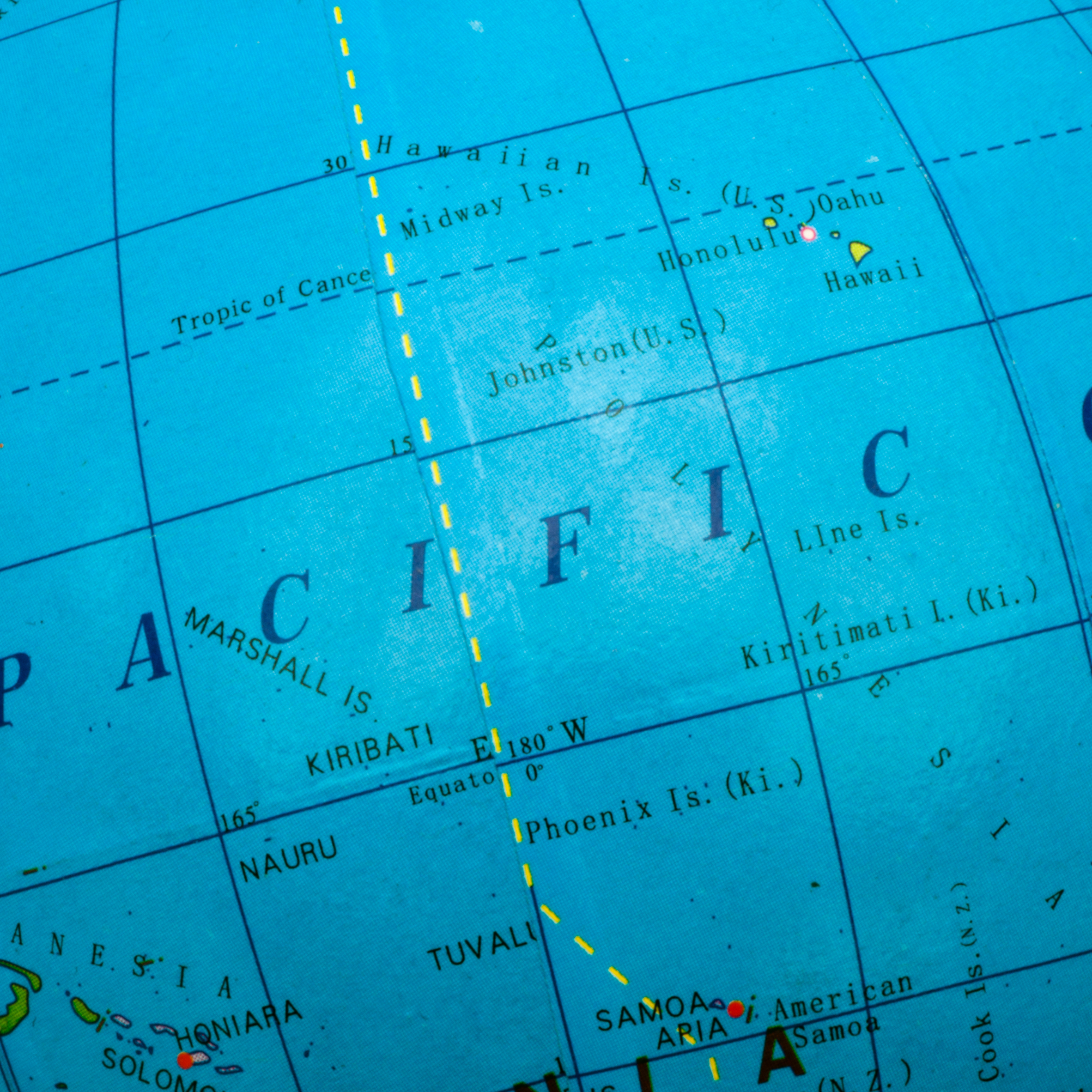
Crossing the Pacific Ocean is a huge undertaking that only the most confident and experienced sailors and motor yacht captains have accomplished.
It’s a 3,000 nautical mile journey across unpredictable waters. You can come across long periods of calms, high winds, and rough seas. Yet, every year a number of brave boaters cross this huge expanse of water.
When was the Pacific ocean first crossed?
The first transpacific crossing was recorded in 1521. Portuguese navigator Ferdinand Magellan discovered the Strait of Magellan in 1521, after exploring much of the Southern tip of South America. Finding the way across the strait took Magellan and his men 38 days. They then spent 99 days crossing the ocean westward and landed on the island of Guam.
Can a motor yacht cross the pacific?
A big ocean-going motor yacht with massive fuel (gas) capacity can cross the Pacific Ocean.
In 2017, a Nordhavn 120 was delivered from China to British Columbia . The trip covered 6,000 nautical miles and lasted 38 days. It was no small feat, which is why it ended up making the news. Most people sail across the Pacific on a sailboat, covering roughly a minimum of 3,000 nautical miles.
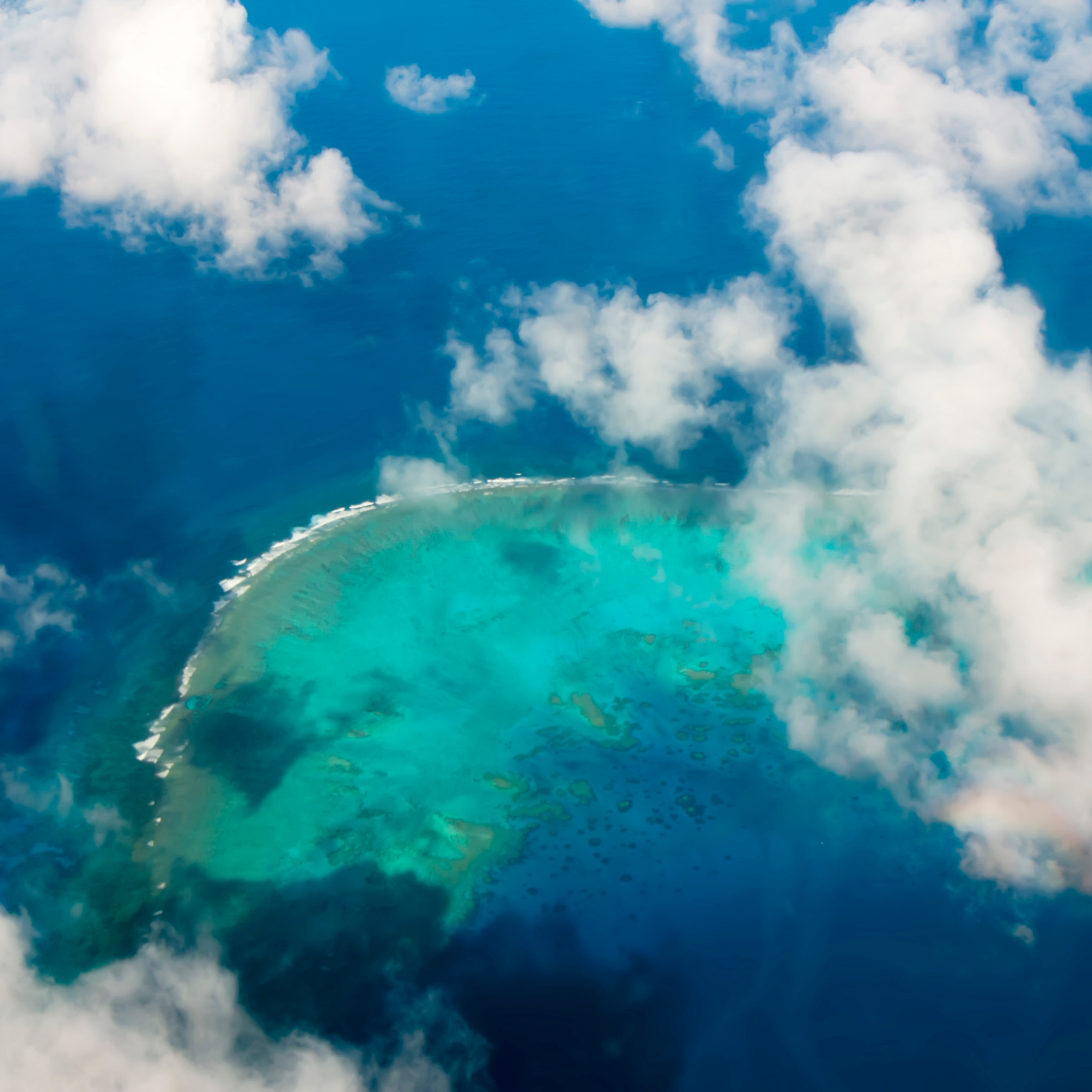
How long does it take to cross the pacific by boat?
It depends on the speed of your boat and the weather conditions, as well as which route you choose.
Most people cross from Mexico to the Marquesas, which is a little over 3,000 nautical miles. The Galapagos used to make for an excellent jumping off point, but the cost and conditions of a stay are ever-changing.
Get the free DECKEE boating app
DECKEE helps you plan, prepare and explore the waterways with confidence.
Download app
What is the best time to cross the pacific?
It depends on where you start and finish your passage. You need to plan your route based around two tropical storm seasons. In the Eastern North Pacific, hurricane season runs from June to November. In the South Pacific, cyclone season occurs between November and May. You can sail in each area safely if you avoid the tropical storm seasons.
For example, if you're going from the US, Mexico, or Panama to the Marquesas, you'll need to cross between April and June. If instead you're crossing from Australia or New Zealand to Tahiti, plan your journey between May and July.
Pacific crossing routes?
There are many routes you can pick to cross the Pacific Ocean. Each traditional route is based around weather and wind patterns (the so-called trade winds).
If you start from the San Francisco area, you can head to Hawaii and then onto the Marquesas. Or you could sail south from there, towards Mexico, and leave Cabo San Lucas to sail directly to the Marquesas.
Alternatively, if you depart from Panama, you can stop at the Galapagos Islands and then continue on to the Marquesas or the Tuamotu Archipelago.
From the South Pacific, you can take shorter passages to get to New Zealand, Fiji , Australia, the Cook Islands, and more.
Starting your voyage from Australia, you can cross to New Zealand and then stop at the Society Islands. From here, you’ll need to set your course north to Hawaii and then continue up towards Canada.
If you leave from Papua New Guinea, you can cross to Japan, rest and then take a route north towards Canada.
These are just some of the traditional route options you have, which are strictly based on the trade winds' patterns. More and more people are now crossing the Pacific at different times, setting their own course. Modern weather forecasting and satellite communication make the crossing a lot safer.
If you’d like to cross the Pacific one day, you’ll need to buy a highly-regarded guide book, such as World Cruising Routes by Jimmy Cornell. These guides contain essential information to help you pick your route and weather window. The best time of year to cross will depend on which route you take and where you plan to spend the cyclone season.
Don't forget to research ports of entry for each country, as you will need to check in before you can explore anywhere on land.
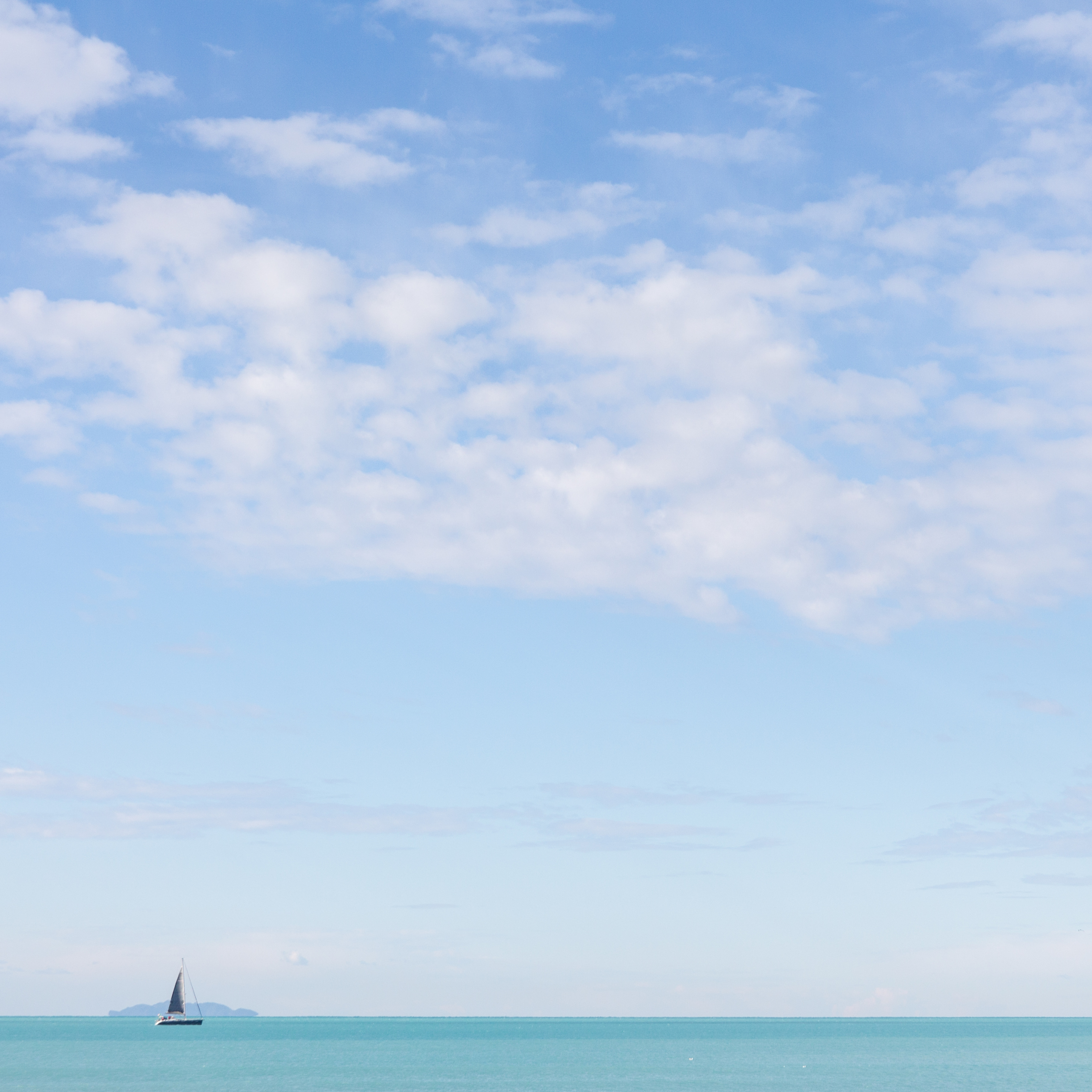
How safe is it to sail across the pacific?
If you cross on a solid and well-maintained boat, with an experienced and capable captain, it can be fairly safe. Of course, you need to take as many safety precautions as possible. Wear a tether and lifejacket on deck and in the cockpit, carry two satellite phones, have the life raft checked before you leave, carry extra food, and more.
Like any big boat adventure, there are risks involved, but you can reduce them significantly by taking your safety seriously.
How big should my boat be to cross the pacific?
Size is important when it comes to an ocean crossing. The bigger the boat, the more comfortable the ride. However, sea-worthiness is crucial. A small boat may be better-built and safer than a big yacht. It all depends on how sturdy it is and what gear you install on board. That said, for a comfortable ride, you’ll want to cross on a boat around 40ft long.
If you’d like to find out more about what makes a blue water sailboat, have a look at this article .
RAFTING UP WITH OTHER BOATS: TIPS AND TRICKS
Are boats a good investment.
- Meet the Team
- Our Manifesto
- Work with Us
- Budget Travel
- Personal Development
- Work & Travel
- United Kingdom
- More of Europe
- Philippines
- More of Southeast Asia
- More of South America
- More of Central America
- South Korea
- More of Asia
- More of North America
- New Zealand
- Pacific Islands
- More of Oceania
- South Africa
- More of Africa
- More of the Middle East
- Travel Essentials
- Travel Gear
Home » Budget Travel » Sailing Across The Pacific: The ULTIMATE Sailboat Adventure! (2024)
Sailing Across The Pacific: The ULTIMATE Sailboat Adventure! (2024)
A freshly caught tuna sizzles in sesame oil. The Milky Way is so clear, you feel like if you just reached your hand a little further you might just touch the stars. Waves lap against the hull, and that’s about the only sound you hear.
This is how I remember sailing across the Pacific Ocean . Nostalgia hasn’t rose-tinted all the memories, though. There was still the maddening autopilot who gave up the ghost only twelve days into a month long passage (you little @#*!).
Crossing the largest ocean on earth by sailboat is no easy feat, but it brings with it an elation and joy that is unique to offbeat travel. No one can take away the fact that you did it. You crossed an ocean.
Now, what does it take to sail across the Pacific Ocean? Just a good floating tin can with some sails and enough coffee to kill a bear. 😉 Kidding aside, I strongly believe that with good preparation and training, anyone can learn to sail and cross the Pacific Ocean.
You just need:
- The best routes
- Some juicy inspiration
- Practical tools and tips to prepare your boat (and your crew)
And that’s where I come in! So let’s get into it – let’s get you ready to cross the Pacific Ocean by sailboat!
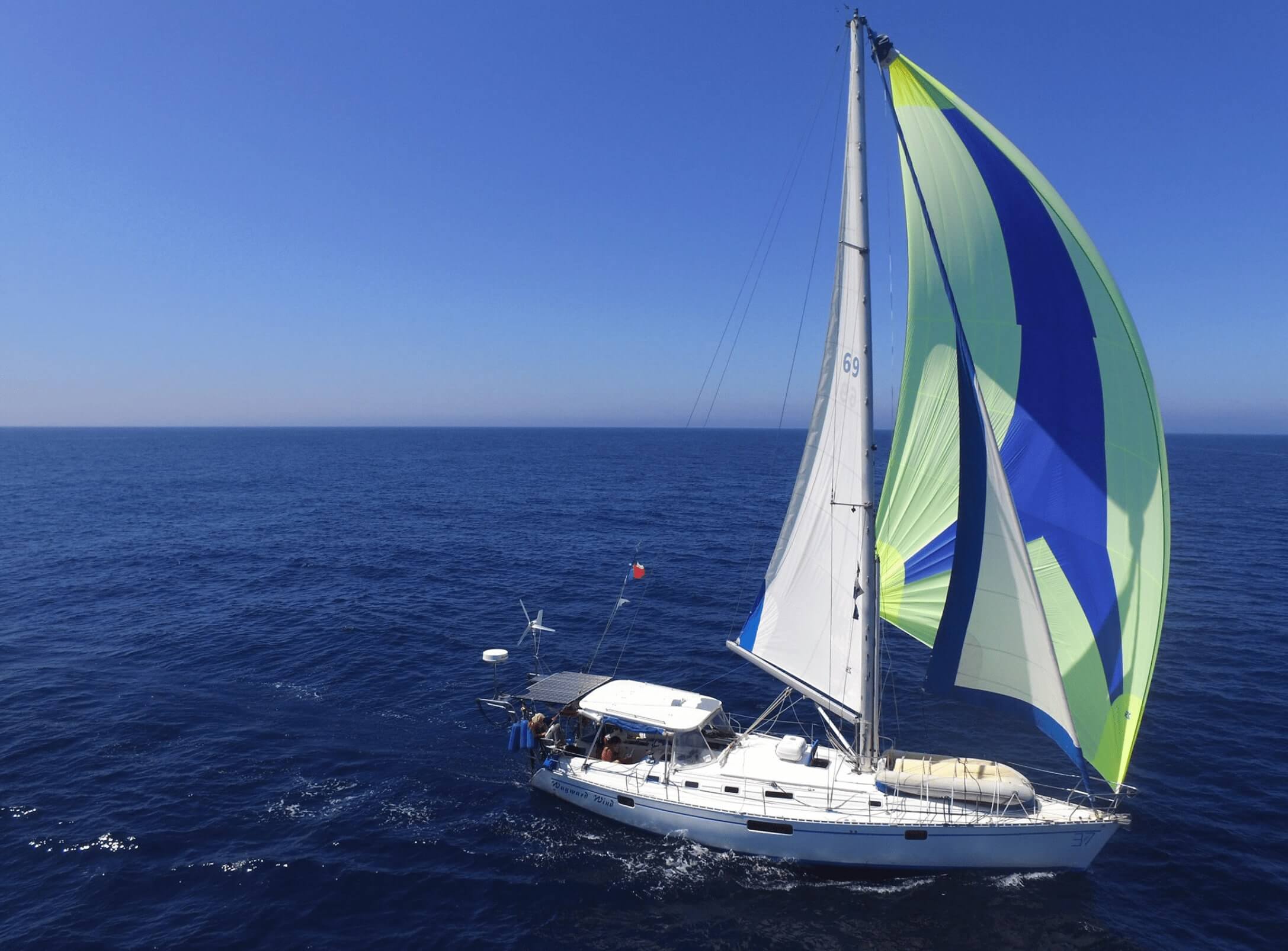
The Broke Backpacker is supported by you . Clicking through our links may earn us a small affiliate commission, and that's what allows us to keep producing free content 🙂 Learn more .
Crossing the Pacific Ocean in a Sailboat – WHY?
- Sailing Routes Across the Pacific(and how long they take)
Oh, the Places You’ll Go (during your Pacific passage)
When to jump the pacific puddle (so you don’t die), what you will need to cross the pacific ocean by sailboat, faqs about sailing across the pacific, final thoughts on sailing across the pacific.
- Buy Us a Coffee!
What kind of maniac dreams of sailing across the Pacific? What kind of person puts thousands of nautical miles between them and the nearest semblance of land?
The Pacific Ocean has been singing a siren song promising palm trees, balmy weather, and peaceful winds for centuries. You’re completely unplugged – so no damn Instagram! For many sailors – veteran and greenhorn alike – it is the ultimate, goldilocks cruising grounds.
“The principal difference between an adventurer and a suicide is that the adventurer leaves himself a margin of escape.” – Tom Robbins
To cross the Pacific Ocean by sailboat represents an accomplishment that no one can take from you. It is indeed an adventure of epic proportions. Long night watches, daily face-offs with the elements, fixing the umpteenth broken thing… it is no easy feat! But anyone with a little preparation and a bit of know-how can leave themselves a margin of escape.
With a little initiation into the trials and tribulations of boat life , a cornucopia of experience awaits the adventurer who sails across the Pacific.

Unlock Our GREATEST Travel Secrets!
Sign up for our newsletter and get the best travel tips delivered right to your inbox.
Sailing Routes Across the Pacific (and how long they take)
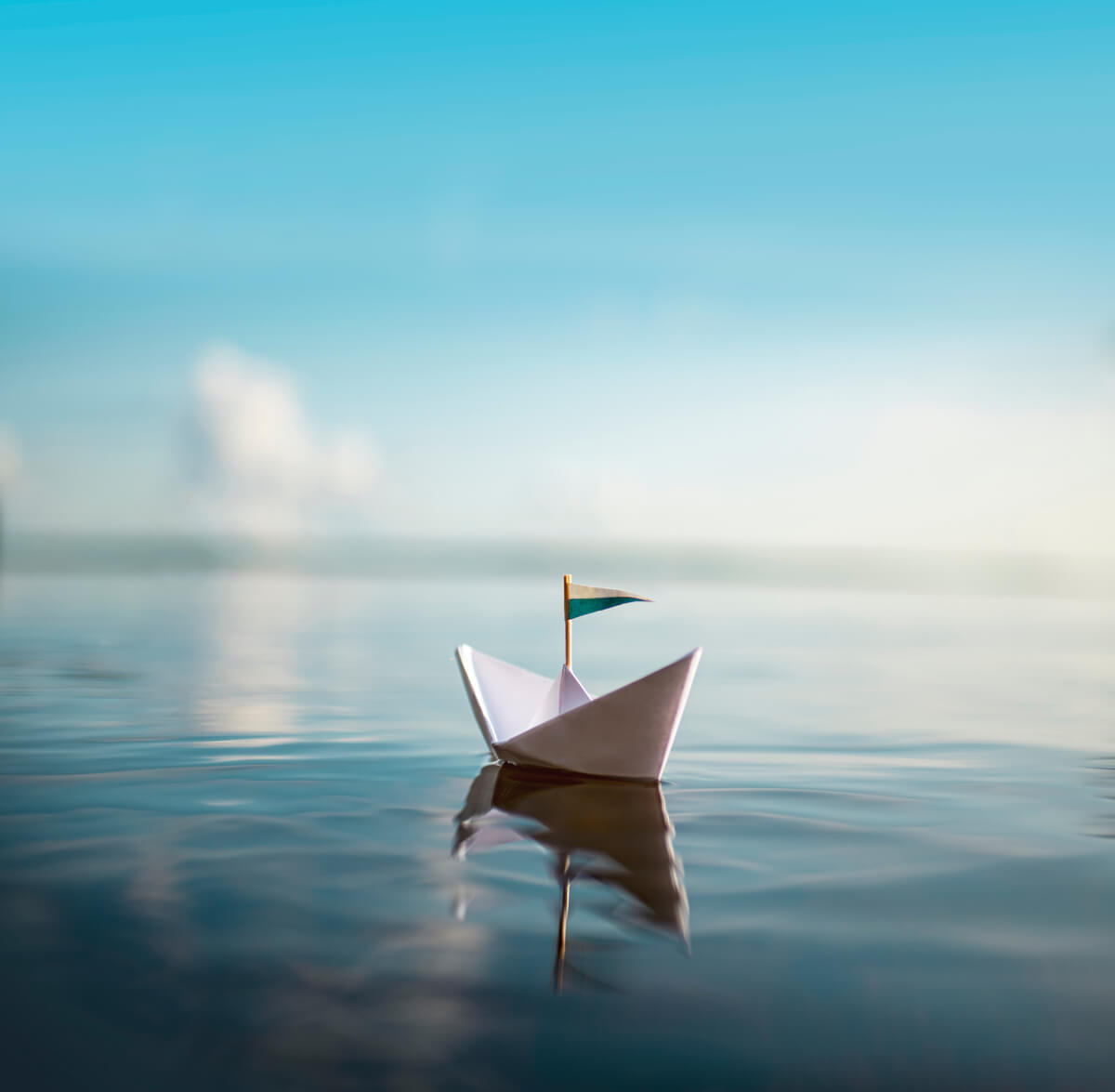
The sailor knows that there is no point fighting the wind. So, a successful passage across the Pacific depends on good winds. Generally speaking, this lends itself to an east-to-west crossing.
All good boat plans are written in the sand at high tide, so of course, there are some deviations from the popular route. But, there are still vague targets and timelines that guide your Pacific Crossing.
Sailing the Pacific Ocean from East to West – The Coconut Milk Run
From the moment Magellan stuck his nose out from Panama and declared it Mar del Pacifico , this is the route sailors have favoured.
Your trip can begin with a little visit to Panama , heading south to charge through the notorious ICTZ, and riding the south-easterly trades all the way to French Polynesia. Some will stop in and travel the Galapagos, others will charge on through.
How long does it take to sail across the Pacific from East to West? This passage can take anywhere from 23 to 40+ days in a sailboat.
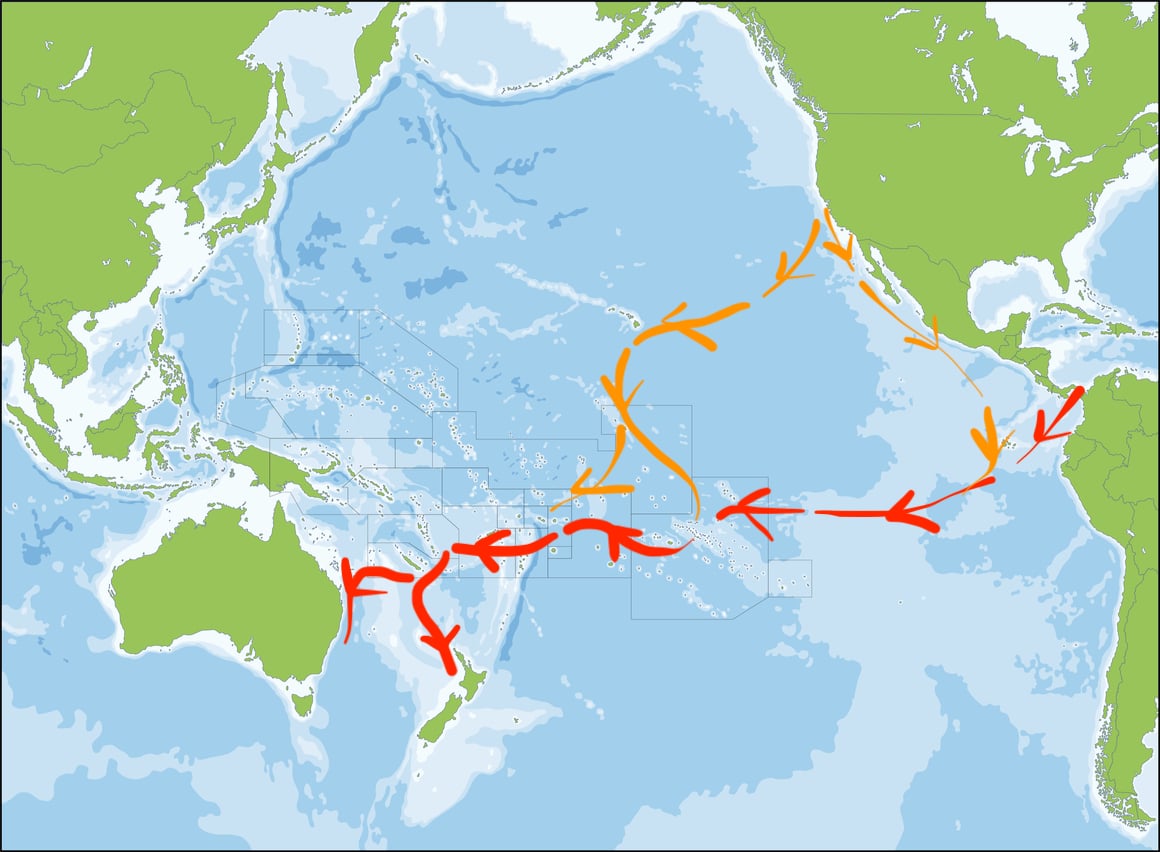
There are variations on this Coconut Milk Run. You can set off from Mexico or Ecuador, for example. Maybe this is part of a larger circumnavigation and you’re fresh off a season in sailing the Caribbean or an Atlantic Ocean crossing.
You can go onwards to Australia and New Zealand, or get stuck in the South Pacific. Even going on to travel Southeast Asia , or India, are not out of the question for the brave circumnavigator.
Wherever your starting point is in the east, you will spend a month (give or take) without seeing land. Just you in your tiny boat-universe traversing the sea and the stars.
Sailing the Pacific Ocean from West to East
Call me lazy, but this is a hard slog. Nothing is ever impossible, but you’ve got to have some patience with the winds to sail across the Pacific Ocean from west to east. If the early Polynesian navigators can do it, though, so can you and your tin can.
The three main options for sailing from west to east are:
- The “Direct Route”
- The Roaring Forties
- The Northern Route
Ok, I lied – I would love to do the Roaring Forties passage! Anyway, this is not about Indi’s Secret Planning to Cross the Pacific Ocean Again. This is Serious Writer Business.
So, the Direct Route has the disadvantage of it being primarily upwind. But if you’ve got a well-prepared boat – and well-prepared crew – it can be fast and exhilarating.
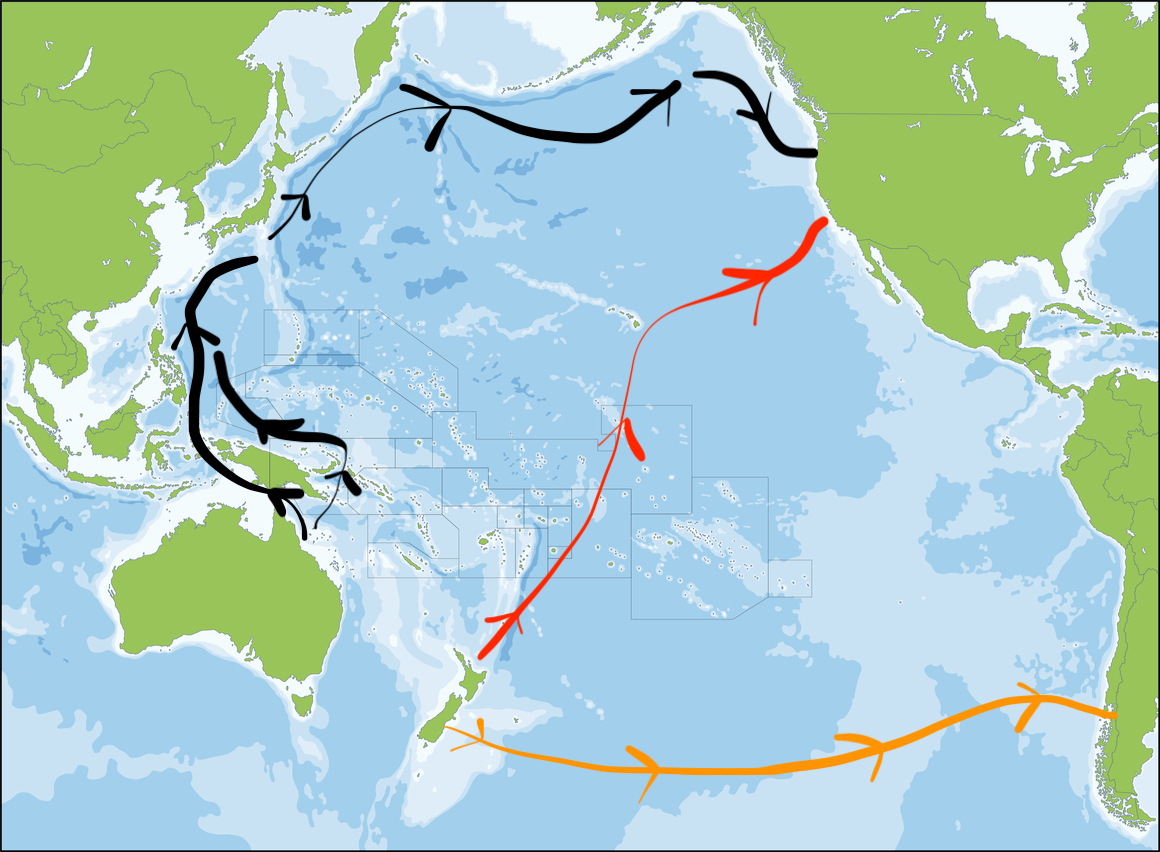
The Roaring Forties has broken stronger sailors than me. How long does it take to sail across the Pacific from West to East? Well, It’s a long passage – 40 to 50 days . Extreme latitudes and rolling seas mean you need a well-stocked boat – and hardy crew. Also, the point of cruising the Pacific is usually balmy weather. There’s not a lot of balmy weather down there, mate. But if you can hunt around for the right latitude, it’s downwind sailing (yay)!
And then there’s the Northern Route. Basically, this is several smaller passages up through the Coral Sea, through Southeast Asia and Japan, and then across the Northern Pacific. An EPIC bucket list adventure if I ever dreamed of one! You can hunt around for good wind on this passage, but again, you’ll need a resilient crew and boat ready to take on the many nautical miles to be covered.
Want to save money on accommodation?

We got you. For reals.
If we look at a map of the Pacific Ocean, you’ll notice it’s mostly blue. On one side is the Americas, and somewhere over there is Australia and New Zealand.
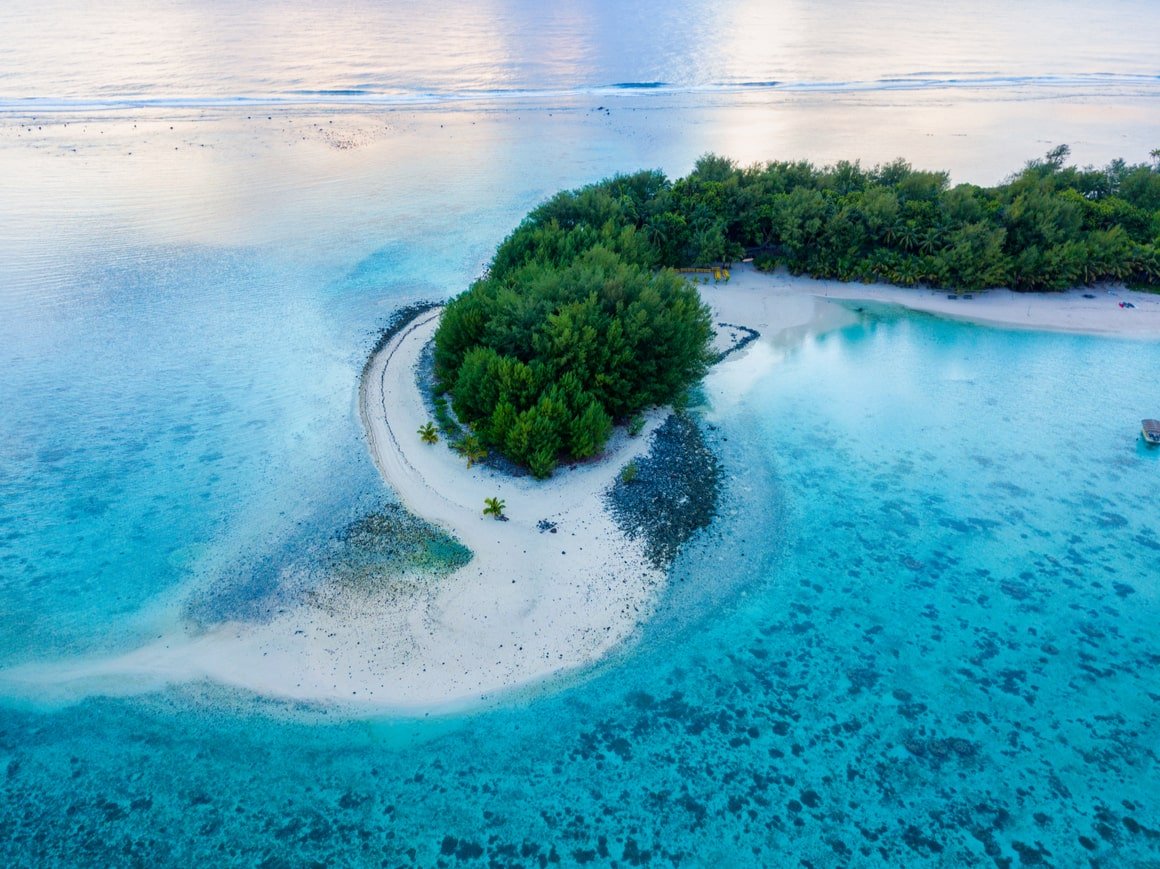
But scattered across this great blue spectacular, are various incarnations of paradise on Earth. Oh, the Pacific Islands! You marvellous little delights full of genuine offbeat travel!
Sailing in French Polynesia
After travelling Panama, or elsewhere in the Americas, you’ll likely arrive in French Polynesia .
There are three main groups of islands. There are the Marquesas, the Tuamotus, and the Society Islands. Your first port of call after the big crossing is likely going to be the Marquesas.
The Marquesas are epic volcanic islands that tower over deep waters. There is some cheeky hunting and epic hiking here, as well as cheap baguettes. It blew my mind that in the middle of the Pacific there was cheap, French bread!
However beautiful these islands are, though, the stereotypical shallow, blue waters teeming with coral reefs are not here.
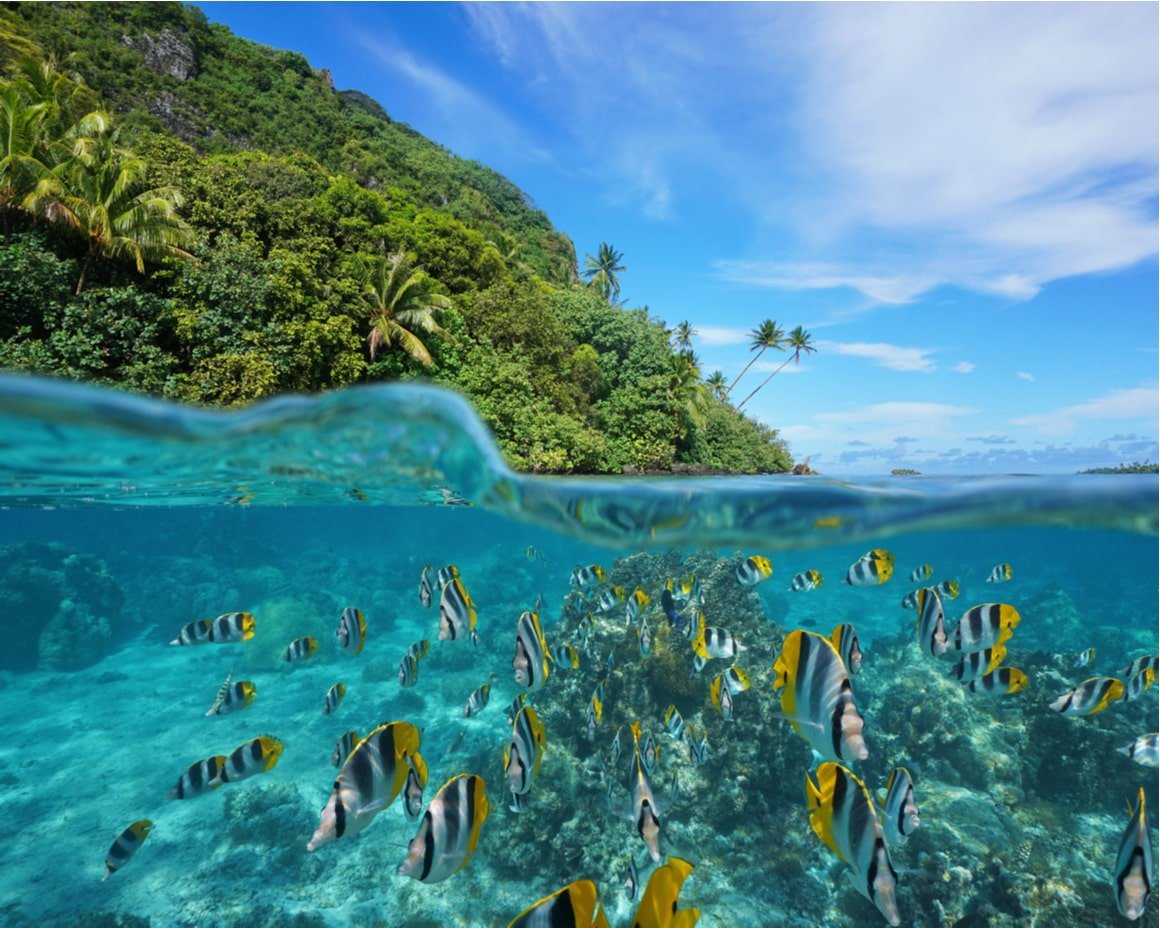
You must press on to the Tuamotus and Society Islands for that. I reckon you could get lost in the Tuamotus for a lifetime – as long as the freshwater doesn’t run out.
The world’s best scuba diving, spearfishing, and lazy hammock days are your juicy reward for crossing the world’s greatest ocean! Not too shabby.
Sailing in the Cook Islands
The Cook Islands Exclusive Economic Zone (EEZ) is 2 million square kilometres! You can’t expect to know this series of islands intimately in just one visit. Still, good fishing, chatty locals, and picturesque islands make it worth sailing through. Travelling to the Cook Islands (and briefly becoming a mermaid) may be just what you need to avoid travel burnout .
Palmerston Atoll is only able to be reached by boat. It is a series of islets whose inhabitants can all be traced back to one man – William Marsters. Island time becomes more prominent the further away from continents you get. So by the time you get to Palermston Atoll, you can throw your watch overboard!
Throughout the Cook Islands, a slow tempo to living is the norm. Expect to chat lots with strangers, explore uninhabited islands, and wonder why you’d ever return to “normal” life. If I ever end up on the run, don’t go looking for me (or my mermaid look-alike) in the Cook Islands! 😉
Sailing in Fiji
As you continue your westward sailing across the Pacific, you will probably make a stopover and stay in Fiji .
Fiji is a bit of a crossroads within the Pacific. It is both Polynesian and Melanesian, and it is also home to a large Indian diaspora. While much of the Pacific escaped a strong colonial presence, Fiji did not. Along with its own kingdoms and chiefdoms, the British stuck their nose in and left a muddy footprint on Fijian culture.
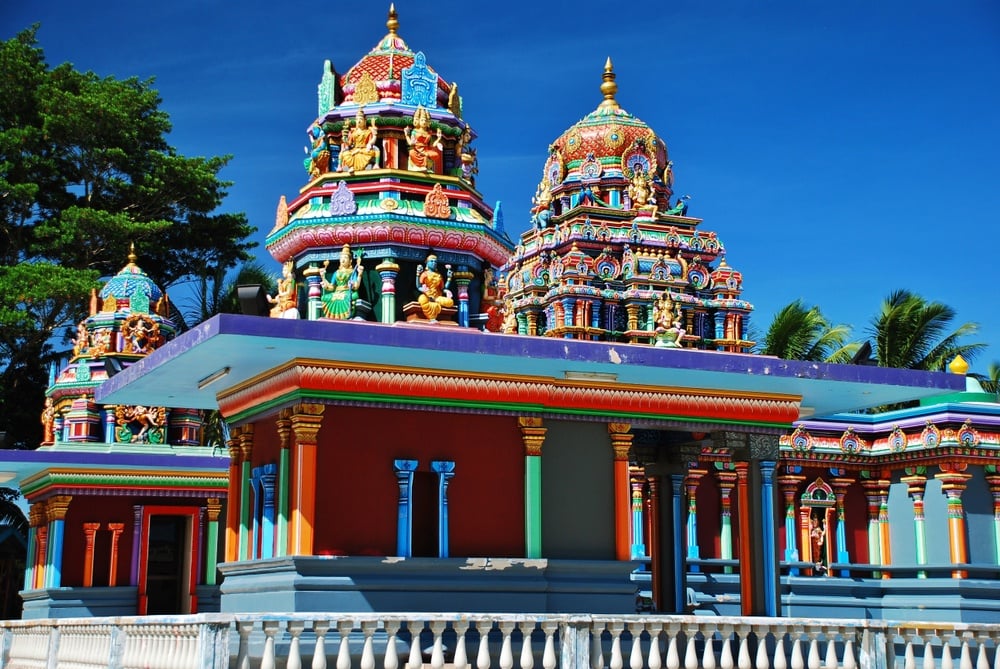
The British chose the rainiest place in the Pacific as the capital of their colony – Suva. Because of course, they did. Suva will probably surprise first-time visitors – it’s fewer palm trees and coconuts and more traffic and nightclubs.
Suva aside, the rest of Fiji is as remote and gorgeous as you’d expect the Pacific to be. Sailing through Fiji is a reminder that the Pacific is as complex as the rest of the world – it just has more white sand beaches!
Sailing to New Zealand
If you make it to New Zealand, pat yourself on the back! You crossed the Pacific freaking Ocean – fuck yeah!
If you take the east to west passage across the Pacific, chances are you’ll end up in Aotearoa, New Zealand. The kiwis are pretty comfortable with their status as a Pacific Island. Along with the first real supermarkets on this side of the Pacific, there are familiar smatterings of Polynesian culture.
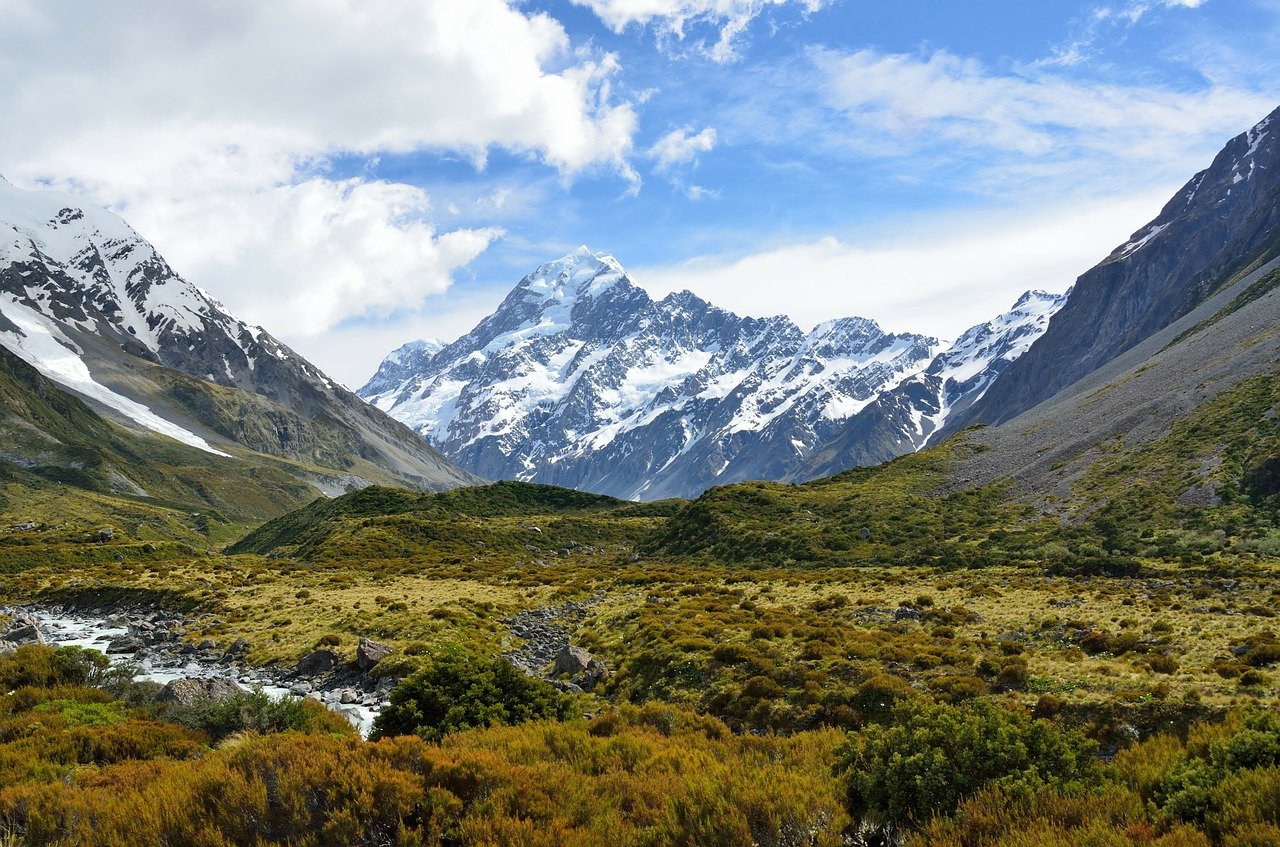
Dammit New Zealand, you’re pretty freaking sweet! Road tripping around New Zealand is bloody dreamy: the hiking and the mountains are off the charts, and the people are just so friendly! If there were ever a sticky place to tempt my wandering feet to settle down, it’d be New Zealand. Plus, the diving is pretty great .
Some sailors choose to sell their boats here. Some choose to slow down and spend a season working or exploring New Zealand. Eventually, most sailors have to move on. Travelling to New Zealand is a very special experience that will have most sailors scheming about how to get back!
Sailing to Australia
Maybe you bypassed New Zealand and came straight across the Pacific to Australia. Maybe you added crossing the Tasman Sea to your growing list of sailing achievements. However you made it, and whatever customs form you had to fill out to prove it, you arrived in Australia – the famed Land Down Under.
A pretty epic continent is bound to get under your skin. She’s bold, she’s beautiful, and she’s stinking hot! There are countless incredible adventures to be had in Australia!
Australia is less keen on embracing its geographical status as a Pacific or Asian country. It’s a whole different kettle of fish down under, mate.
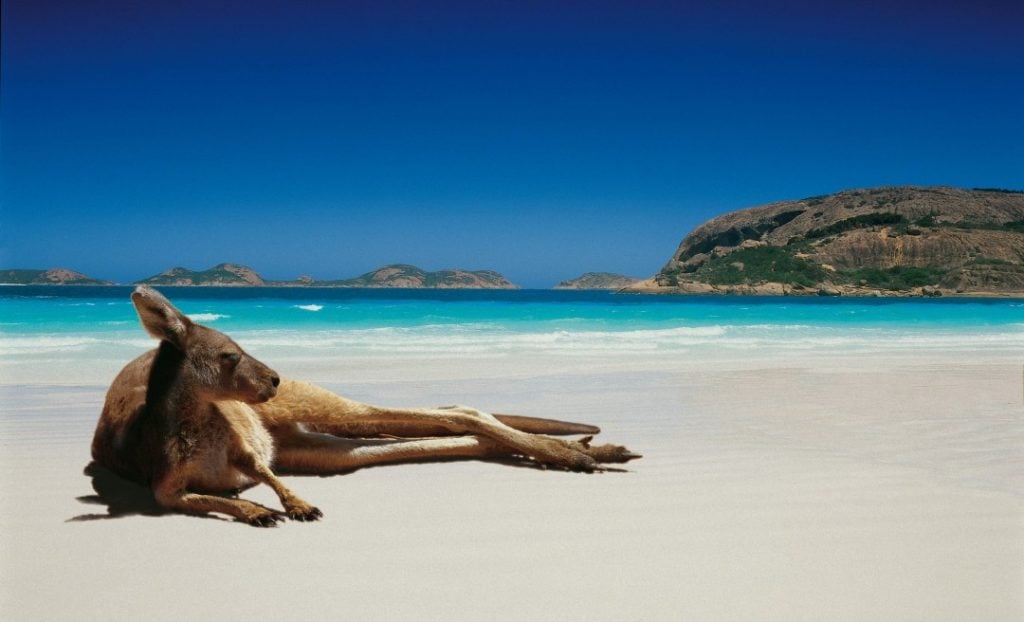
There are sweet Australian road trips , and working opportunities abound for the boat bum. You can easily restock the cruising kitty for a season before continuing your sailing circumnavigation. There’s also a pristine and sparsely populated coastline good for nothing but surfing and sailing!
I reckon the reason you don’t see too many Australian sailors around the world is that they see no reason to leave their beautiful home.

Wanna know how to pack like a pro? Well for a start you need the right gear….
These are packing cubes for the globetrotters and compression sacks for the real adventurers – these babies are a traveller’s best kept secret. They organise yo’ packing and minimise volume too so you can pack MORE.
Or, y’know… you can stick to just chucking it all in your backpack…
Danger is a relative concept. Crossing the street and driving a car is dangerous, but we all do it every day. Crossing the Pacific Ocean can be dangerous, but you can mitigate those risks.
People always ask me how bad the weather was at sea. Were there storms? They don’t ask about keeping healthy while travelling, breakdowns at sea, or navigation nearly as often. A storm holds a captivating spot in our psyche – and for good reason.
It’s worth remembering that your boat is probably stronger than you. You shouldn’t get into your life raft until you are stepping up into your life raft. Extreme situations aside, there are safer times to cross the Pacific! And more comfortable times too. So when is it best to sail across the Pacific Ocean?
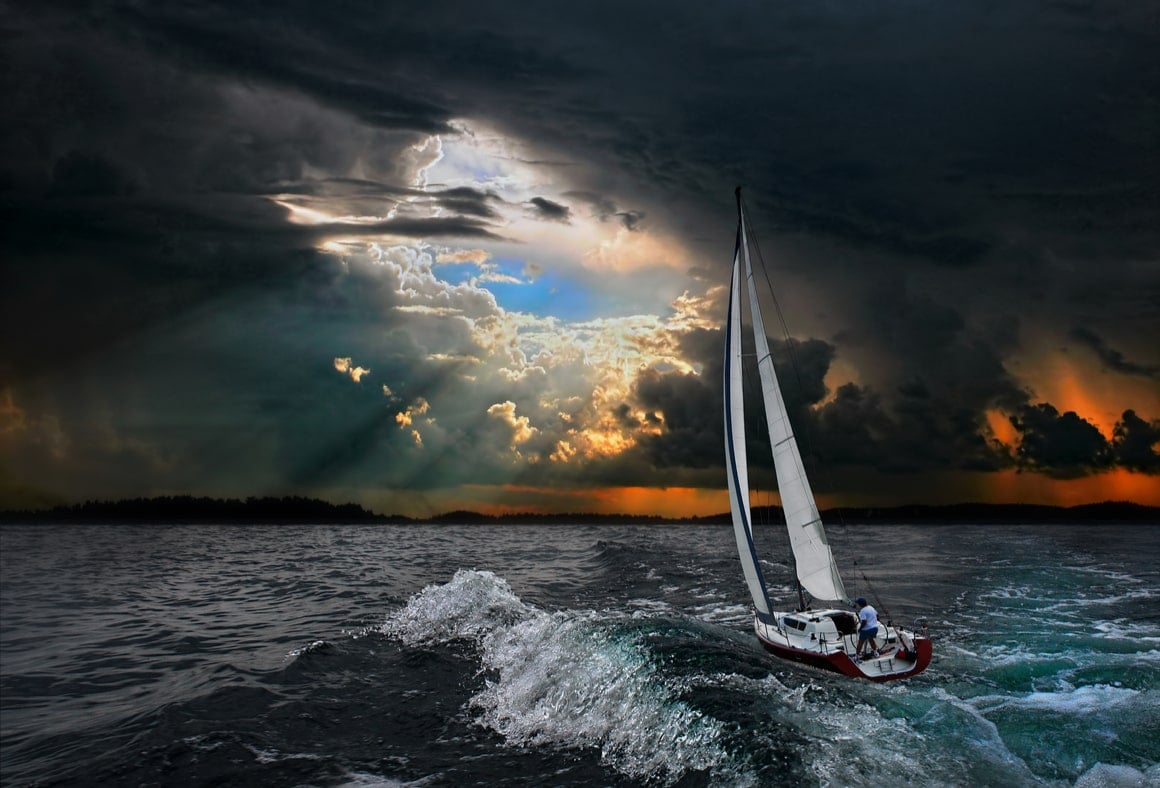
The boat sinking storms are concentrated in hurricane or cyclone season. Luckily, these seasons are quite well known now. If you are in the South Pacific between November and April, your chances of a cyclone are high. But, come May, the odds drop to almost zero. Cyclone season in the North Pacific and the Caribbean is June through November.
With this in mind, the best time to sail across the Pacific Ocean becomes clearer. If you leave Panama around March , you will arrive in the South Pacific right at the beginning of the best cruising season. You will also avoid the cyclone season of the Caribbean.
There’s no point fighting the winds, man!
You need a sailboat that is stem to stern ready. You also need a crew that is in tip-top shape and mentally prepared for the long passage ahead. Realistically, anyone who is prepared can take on sailing across the Pacific Ocean. But what does it look like to be prepared?
The Trial by Sailboat – LIVEABOARD EXPERIENCE!
Before literally chucking yourself in the deep end by sailing the Pacific, why not rent the boat life? Try your hand at skippering a sailboat bareboat (without captain or crew) so you can stress-test yourself as a sailor. Sailo lets you do exactly that!
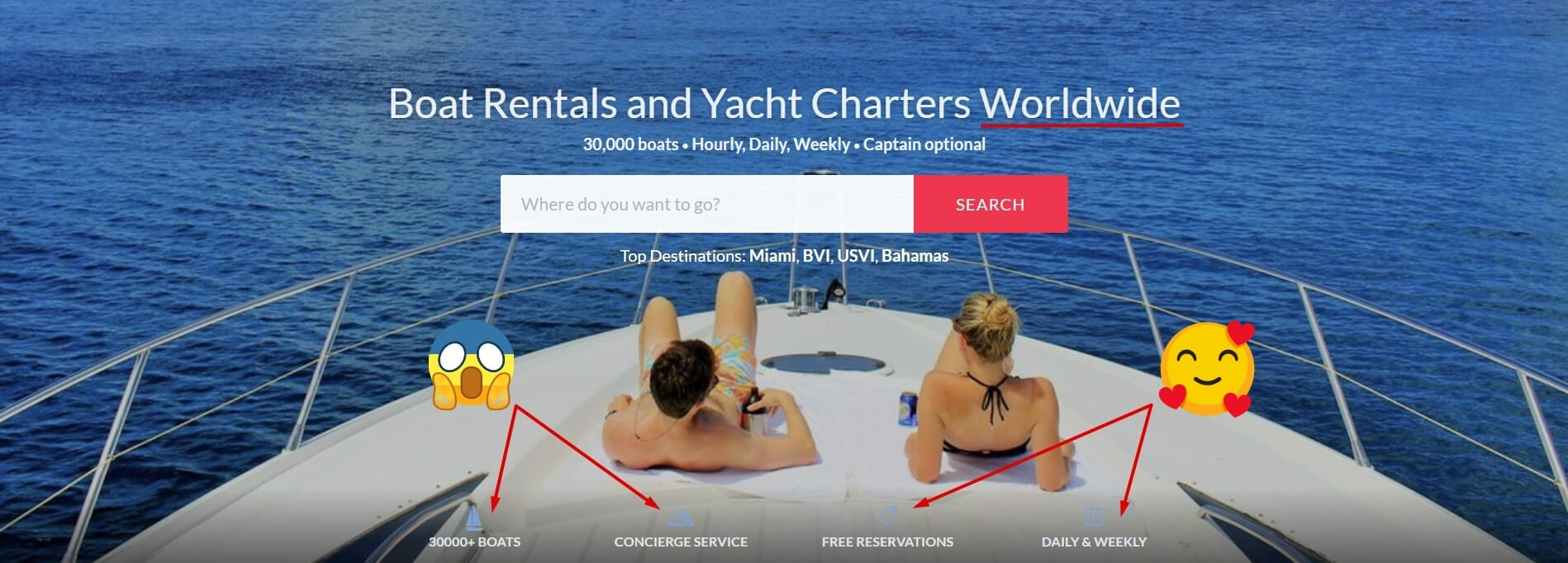
You can rent one of over 30,000 boats. If you’re not up to skippering your own boat, then kick back on one of the many catered charter boats on offer! You’re guaranteed to find something suitable and have a splashing good time in the best places in the world to sail.
It’s not the most hardcore jump-in-the-deep-end training for your Pacific passage, but having a taste of the boat life is probably a good idea! It’d be a bit awkward if you got halfway across the Pacific only to realise this whole boat life wasn’t for you.
Boat System Preparation
Being prepared to sail across the Pacific Ocean means knowing your boat at least as well as you know your smush buddy.
I like to remember that a day spent preparing in the dock is worth a week at sea. When you walk around your boat, ask yourself: how likely is this to break, and if this broke, could I fix it? Preparing systems and the backup systems to backup systems is all part of your preparation.
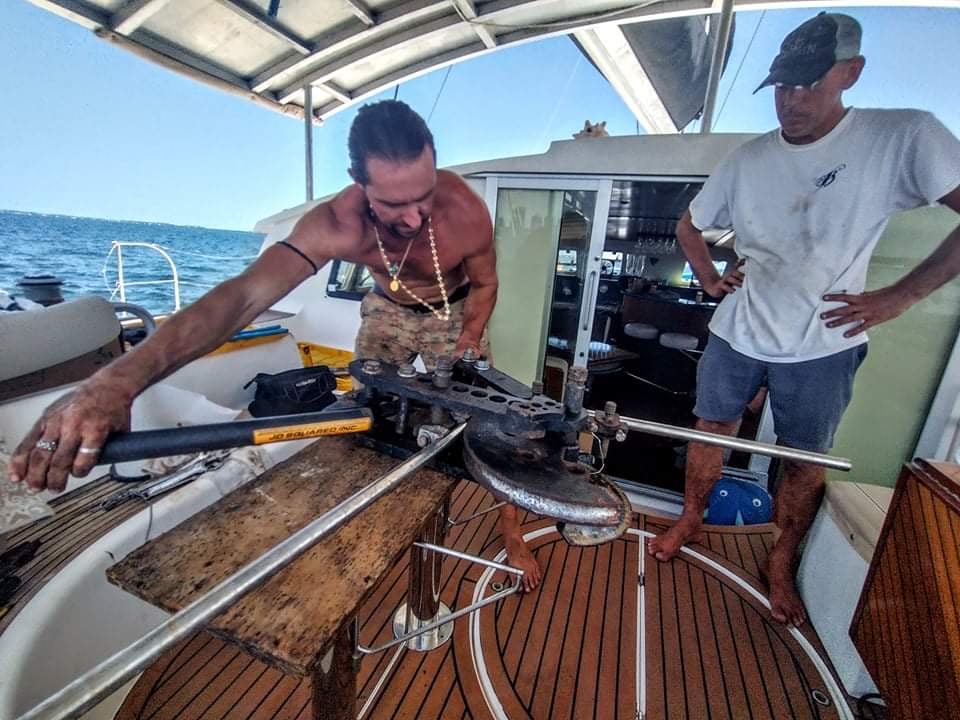
Ultimately though, you need to be flexible. You might not leave port knowing how to sew anything more than a button to your pants. But if push came to shove, you would learn real fast to mend your sail.
Knowing how to use both charts and electronic navigation is useful. Keeping in touch via the radio is also a useful – and fun – way of getting weather and gossip. Nothing says boat life like a radio crackling to life somewhere off the coast of Ecuador.
“Hola amigo, cual es tu posicion? Y cuidado con los monstruos!” It’s the first voice you’ve heard in over nine days that didn’t originate from you or your crew. It’s a comfort knowing there’s someone else out there also afraid of the sea monsters!

Essentially, being prepared is about organisation and organisation is about lists.
- Galley lists
- Maintenance lists
- Medical supplies list
- Weather lists
- Reading lists
Aside from adequate supplies, navigation and maintenance know-how, you need to have an adequately prepared crew.

Things go wrong on the road ALL THE TIME. Be prepared for what life throws at you.
Buy an AMK Travel Medical Kit before you head out on your next adventure – don’t be daft!
Sailing Solo Across the Pacific?

An adequate crew may look like just you, yourself, and you. That pun didn’t really work in the third person, but we’re rolling with it.
Sailing solo for long passages like that which is required to cross the Pacific is not unheard of. It is often the preferred way of sailing for old salts. And there is a certain appeal in the solitude of a long passage – it’s the ultimate growth at the edge of your comfort zone .
The biggest hurdle to solo sailing is standing watches. It’s hard to maintain a constant watch and get enough sleep. Usually, a system of radar alarms, twenty-minute nap alarms, and a dash of faith in King Neptune get the solo sailor to their next port.
Knowing yourself and what you are capable of as a sailor is alluring though. Because no matter how well you know another person, you’re always going to know them better (for better or worse) after a long ocean passage.
To Crew or Not to Crew While Sailing Across the Pacific
A big advantage to having two, three, or more, people crewing a Pacific crossing is the night watches. Adequate sleep is a severely underappreciated necessity! Being able to divide the days and nights into shifts means that everyone gets to eat better and sleep better.

But managing dynamics in close confines, far away from any time out spaces, is key. Your friend might be a perfectly competent sailor. When on land you notice that they chew with their mouth open and sometimes like to rant about how the world is going to end in the next ten years.

This is all good when you can leave the bar and have a break from them. All is good when you do small passages with them. But, when you’re in a small sailboat in the middle of the Pacific Ocean, you may not want to hear about the apocalypse for the twelfth time in as many days while watching food entirely miss their mouth.
Vanlife has a reputation for making or breaking relationships. Sailboat life is essentially vanlife without the ability to go for a hike and ignore your partner for a while. There’s also the added dynamic of captain vs crew.
With good communication, sailing across the ocean with your partner can create an unshakable bond that transforms and solidifies your partnership. Without good communication, you might not ever want to see that dickweed’s face again.
So, to crew or not to crew? Personally, I think we’re stronger together than we are apart . I think that sailing across an ocean is a sublime experience that is made easier and more pleasurable when shared. BUT, you need to be honest and aware of the dynamics. Play to your strengths and be accepting of others – and your own – weaknesses.
Mama Moana has a way of humbling us all.
Boat Food is Good Food
To sail across the Pacific, you’re going to need food – obviously! 😉 Each boat will have different capabilities when it comes to storage and fridge capacity, so fresh food may last better on some boats than others.
After a month at sea, cooking is bound to get creative though. Add in the challenges of cooking underway and fatigue and you are primed to get creative in the galley!
Food is fuel and a happy gut makes for a happy mind. Things like lemons that keep well for weeks become a godsend. Rather than see food as a cumbersome challenge, think of it as a means for innovation.

I had a captain who learned to make his own yoghurt. Another who pickled their own foods. Every boat I’ve been on has had its own take on the one-pot curry. Skills like salting fish and baking bread become more accessible when you’ve got nothing but time on your hands!
Sailing across the Pacific is made easier with good supplies and a creative touch in the galley! If all else fails, high protein and high sugar snacks like peanut butter make the night watches go quicker!
Fishing While Crossing the Pacific Ocean
A way to supplement your supplies – and provide some entertainment – is to fish while underway. There are some great books and resources made by far better fishermen than me on this matter.
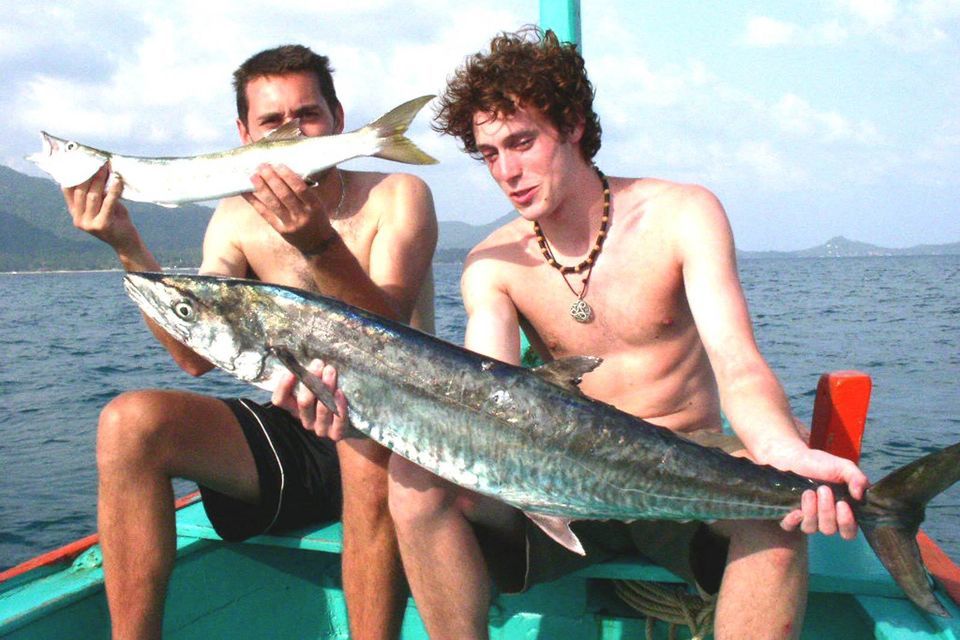
Typically trolling while underway is the method cruisers go for. Once sailors finish the Pacific crossing, having a spear gun or some fishing poles opens up a world of island adventures!
Let’s face it, there’s nothing quite like fresh ceviche!
The Tools You Need to Sail Across the Pacific
There is no way for me to write a succinct list of all the tools you need to sail across the Pacific Ocean. For every system on the boat, you need tools to maintain and repair it. But I wouldn’t want to leave port without:
- Good tool bag and spare parts
- Deck knife (my ever faithful favourite tool)
- Sewing machine
- Multi-tool (my secret second love)
- Solar panels
Staying Safe at Sea
Something sailors – veterans and newbies alike – tend to do is underestimate the consequences of danger. I guess you have to have a certain cognitive dissonance to cast off and not see land for over a month! Maybe it’s called getting old – or one too many close calls – but having insurance kind of puts your rational mind at ease.
You can release your wild side – but you’ve insured its dumb ass!
ALWAYS sort out your backpacker insurance before your trip. There’s plenty to choose from in that department, but a good place to start is Safety Wing .
They offer month-to-month payments, no lock-in contracts, and require absolutely no itineraries: that’s the exact kind of insurance long-term travellers and digital nomads need.

SafetyWing is cheap, easy, and admin-free: just sign up lickety-split so you can get back to it!
Click the button below to learn more about SafetyWing’s setup or read our insider review for the full tasty scoop.
Books and entertainment
Even when on night watch, you need something to keep you occupied. Even between fixing and tinkering things, there is a lot of time when you sail across the pacific. Most sailboats tend to be dry while underway, so there aren’t too many opportunities for drug bending entertainment.
I would recommend downloading podcasts, music, and books GALORE. I personally found movies kind of annoying to sit through, but that’s just me — I know some sailors who smash through tv series like there’s no tomorrow on passage!
What’s important is that you keep your mind occupied. Plus, when do you get a month of uninterrupted learning in your adult life? Why not start learning a new language while sailing?
There are many good books to read while travelling . I think I powered through close to forty books in the first Pacific passage I was on. A couple of books good for the mind at sea are:

- This Old Boat by Don Casey . This is the handiest and easiest how-to fix your broken boat book that I’ve found. There are beginner projects that are best tackled in port, and advanced fixes that’ll save your butt once your in the middle of nowhere. Plus, it’s super interesting!
- Storm Tactics by Larrey Pardey . Pretty self explanatory! And an all round interesting read. In a storm at sea, luck is highly biased toward the sailor who has a plan. A series of user-friendly checklists will help sailors from the moment they start looking for their perfect offshore boat, through outfitting, and as they encounter their first storms at sea.
- Swell by Liz Clark . Captain Liz Clark spent her youth dreaming of traveling the world by sailboat and surfing remote waves. When she was 22, she met a mentor who helped turn her desire into reality. Embarking on an adventure that most only fantasize about, she set sail from Santa Barbara, California, as captain of her 40-foot sailboat.
- Rum Diaries by Hunter S. Thompson . Begun in 1959 by a 22-year-old Hunter S. Thompson, The Rum Diary is a brilliantly tangled love story of jealousy, treachery, and violent alcoholic lust in the Caribbean boomtown that was San Juan, Puerto Rico, in the late 1950s. It’s nice to escape the boat and fall into the drugged up party land of Hunter S. Thompson.
- At the Existentialist Cafe by Sarah Bakewell . Paris, near the turn of 1932-3. Three young friends meet over apricot cocktails at the Bec-de-Gaz bar on the Rue du Montparnasse. They are Jean-Paul Sartre, Simone de Beauvoir and their friend Raymond Aron, who opens their eyes to a radical new way of thinking. No book is better suited to boat life than one about existentialism.

Our GREATEST Travel Secrets…
Pop your email here & get the original Broke Backpacker Bible for FREE.
Can you cross the Pacific Ocean solo?
Absolutely! Sailors have done it before and they’ll damn well do it again! The biggest challenge is making sure you get enough sleep while maintaining good watchkeeping. It can be hard to sleep at the best of times on a boat, but it can be done. Might just be me, but the sea monsters are kinda scarier when you sail alone too.
How dangerous is it to cross the Pacific Ocean?
Far less dangerous than driving a car or riding a motorbike. The dangers that you will face can be mitigated with good preparation. Storms are the easiest to prepare for. Keeping up your health – and sanity – when you’re halfway between nowhere and nowhere is a far bigger hurdle in my opinion. If you can heave-to during a storm, know how to fix the worst of what can break, and eat plenty of citrus – you should be on the right track!
How long does it take to sail across the Pacific?
Depending on the sailboat, the route that is taken, the wind, and the current it can take anywhere between 22 and 40 days. When I crossed from Panama to the Marquesas (sans Galapagos Islands) it took us 26 days.
Why do people cross the Pacific Ocean by Sailboat?
I was going to answer this glibly – we sail across oceans because land life got boring haha. But I think for every sailor who leaves port there is a different reason as to why they are doing it. There is an element of challenge, there are exotic beaches, and long stretches of contemplation. There’s also an element of faith in whatever you want to call it – King Neptune, Church of the Open Sky, regular ol’ God. Sure, you can be prepared and sure, the beaches will be nice. But every sailing trip requires an element of faith .
If the Pacific calls and promises fresh fish, palm trees, and island time – you’ve got to answer! And there is no better way to travel the Pacific than by sailboat. So do your stem to stern inspection, steel your nerves, and cast off to sail across the Pacific Ocean.
The crushed peach sunsets and clear, stargazing nights will reward you tenfold. There are dreamy island paradises scattered across the great blue spectacular and hefty continents on the other side.
Crossing an ocean by sailboat is no small feat. But every mammoth task is made up of smaller puzzle pieces that come together. It is something quite spectacular to crack a beer on the other side of the Pacific knowing that those nautical miles were earned.
Sailing is the ultimate slow travel. An odyssey of mythical proportions lies ahead of the intrepid sailor who takes on such a crossing.
Avast and fair winds, fellow sailors. I’ll see you somewhere in the South Pacific! 😉
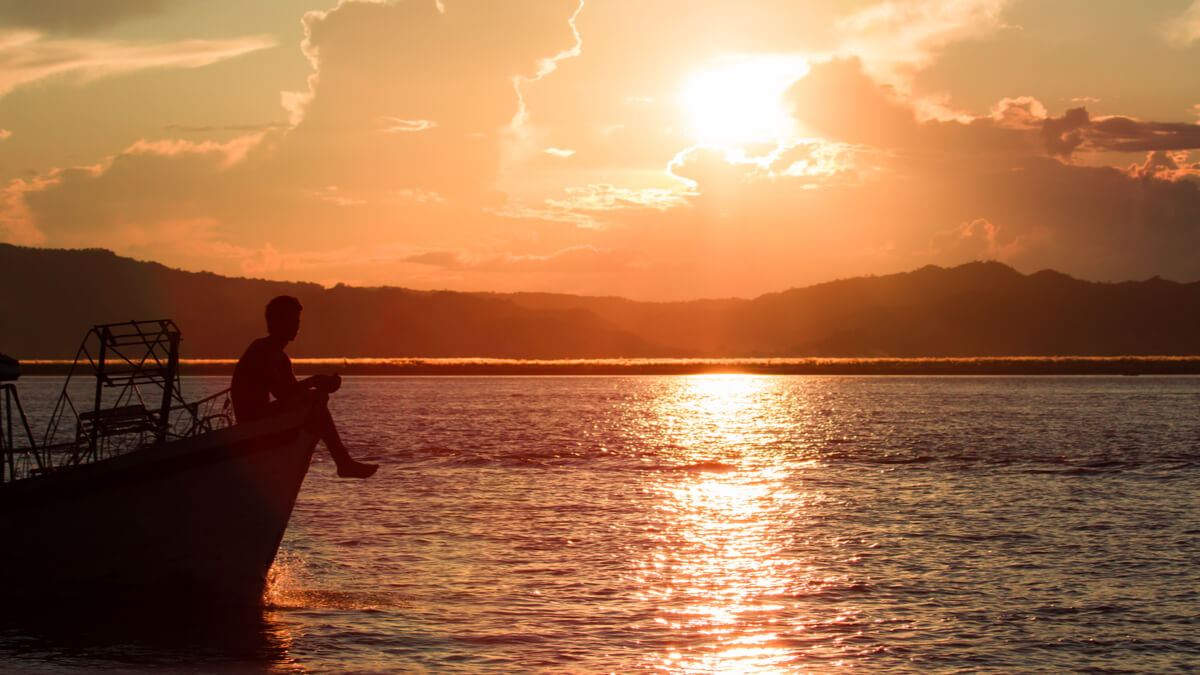
Buy Us a Coffee !
A couple of you lovely people suggested we set up a tip jar for direct support as an alternative to booking through our links. So we created one!
You can now buy The Broke Backpacker a coffee . If you like and use our content to plan your trips, it’s a much appreciated way to show appreciation 🙂

Indigo Blue
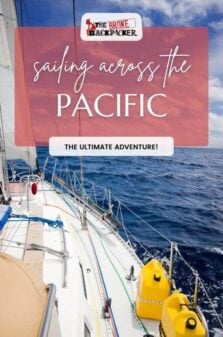
Share or save this post

Thanks! My dream is to sail the south Pacific.
Yeah I’m noticing water maker maybe more important than I thought… I’m just in land sailing 2-4 weeks between re supply missions lol … fuel , food and refill water is tough assignments often over loading my digny in the process.
Wow, take care out there!
Awesome read indigo thanks
Great article!
Leave a Reply Cancel reply
Your email address will not be published. Required fields are marked *
Save my name, email, and website in this browser for the next time I comment.
Notify me of followup comments via e-mail.
- Mediterranean
- South Pacific & Oceania
- South-East Asia
- Indian Ocean
- Northern Europe
- Bareboat Monohulls
- Bareboat Motor Yachts
- Bareboat Catamarans
- Crewed Yachts
- How our services work
- Multi-Database Searching
- Boat Charter Price Guidelines
- Free Charter Guide
- About Sail Connections
- Client Charter Reviews
South Pacific & Oceania Yacht Charter Guide
- Location Guide
Into the Sun on Your Tropical Island Adventure
Sailing a charter yacht in the vast southern Pacific Ocean can be as relaxing or challenging as you want it to be.
Whether taking a monohull yacht to cover the ground and for sheer sailing pleasure, or a catamaran for its space and family comfort, whether choosing a bareboat or skippered option, the charter zones of Tahiti, Tonga and New Caledonia have it all. Spend your entire sailing holiday never leaving the tranquil blue lagoon, or visit places you've read about that require the rewarding experience of a short ocean passage.
Across in Australia. the Whitsundays, 74 tropical islands most of which are uninhabited, lie protected from the ocean by the outer Great Barrier Reef, a true wonder of the natural world. The cruising grounds of the Whitsunday Islands offer an almost infinite number of anchorages suitable for charter boats, with spectacular beaches set against an aquamarine sea teeming with marine life.
The South Pacific Charter Sailing Experience
The tropical South Pacific islands are sailing destinations of peaceful pleasure. The people are welcoming, the sailing season weather is kind, and the natural enviroment is astounding. It's as if these islands have been put there just for you to enjoy, unaffected as they are by outside influence, even in the 21st century.
The southern hemisphere winter is cruising time in tropical waters: go east to Tahiti, west to New Caledonia, or get right to the heart of the Pacific in the Kingdom of Tonga. Fly into Brisbane, Austrlia and explore the nearby Whitsunday Islands. The choices for chartering in the South Pacific & Oceania are as exciting as they are colourful. And access is easy with well-developed air links across the Pacific.
From May to October, the weather is beautifully warm and the trade winds provide sensational sailing conditions in these latitudes. Wherever you choose to charter in the South Pacific, countless places of interest await discovery within practical sailing distances of base port.
The Sail Connections team prides itself in being the South Pacific & Oceania charter specialists. Contact us to discuss your ideal holiday, your sailing charter adventure in paradise.
The Best South Pacific Charter Sailing Destinations
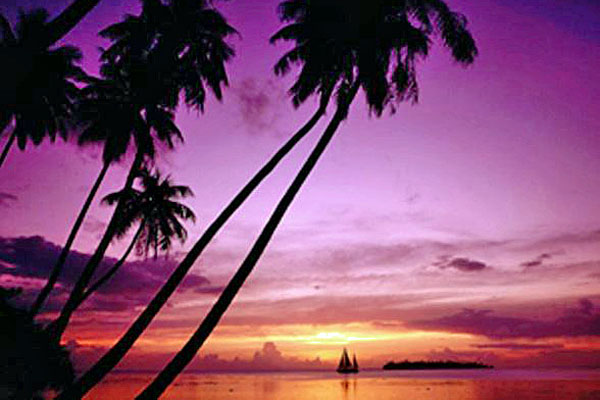
French Polynesia: the Society Islands
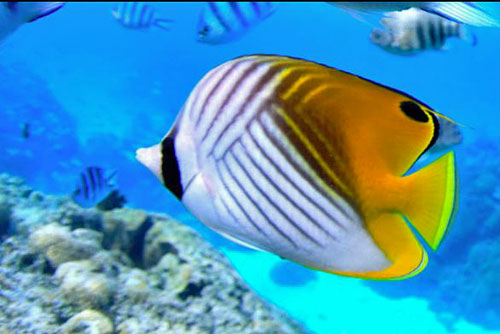
French Polynesia: the Tuamotu Archipelago
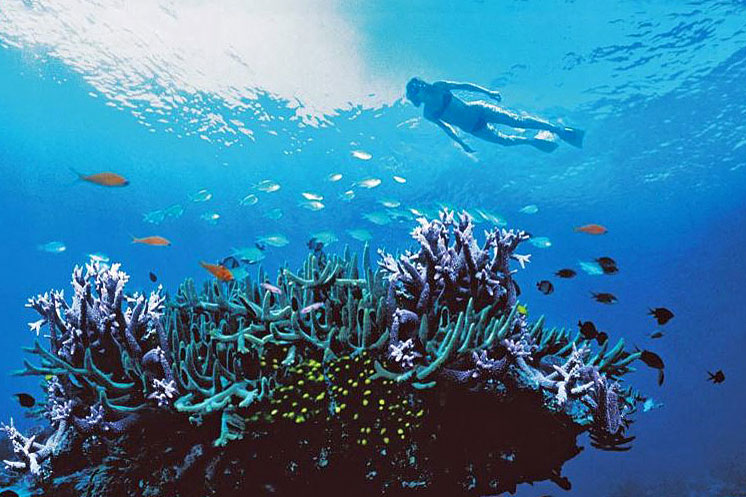
New Caledonia
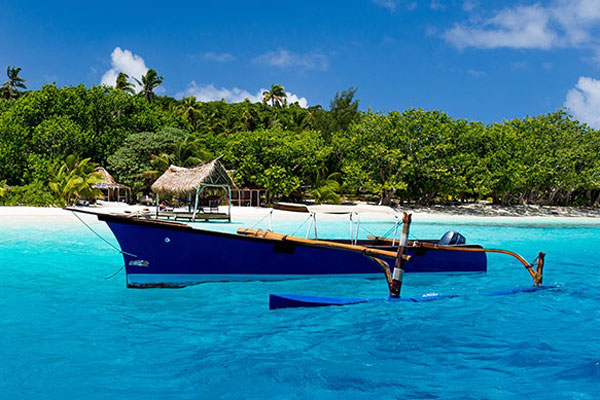
Whitsunday Islands
Latest blog posts.
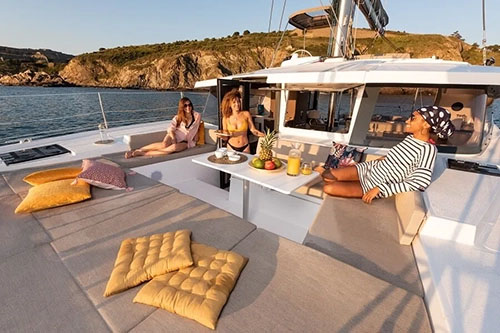
Sailing charter versus resort stay: comparing the costs
A sailing holiday frequently combines with a land-based resort stay. How many nights aboard charter boat and how many nights onshore, or foregoing one or the other due to cost, is often a discussion point. So we did an exercise on the price comparisons between boat and resort. The cost benefits of a sailing holiday are clear
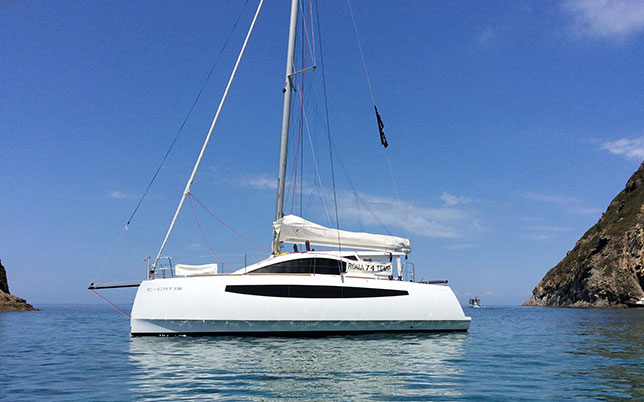
Charter catamarans for modest sailing holiday budgets
Here we highlight some smaller catamarans finding favour with our charterers in the Mediterranean and elsewhere. Robert is our expert evaluator when it comes to helping you select the right boat for your sailing charter, and the following is his personal take on recent introductions to the charter boat market.

The popular Bali Catamaran in all its variations
The Bali catamaran, designed and built specifically with chartering in mind, has become so popular that it’s been hard to keep up with all the new models, hard to spot which one has just the right size and amenities to perfectly fit your group's sailing holiday charter needs. We can help you there.
.jpg)
The value of after-charter destination and boat reviews
At Sail Connections we offer a personal service based on long experience in the business and close attention to what's happening in the destinations we offer. We have also sailed a large number of those places, and can often speak from personal experience. But we can't be everywhere.
-6x4.jpg)
Chartering in Turkiye: feedback we just have to share
Turkey is one of those charter destinations that doesn't fail to pleasantly surprise. We're always delighted when we receive such good reports as we did recently from a New Zealand client.
The Sail Connections Guarantee
One contact - every option - advice you can trust.
- Matching any competitive offer
- Sourcing boats with discounts available
- Personalising our proposal just for you
- Qualifying the operator as well as the boat
- Advising without bias based on 25+ years of experience
- We do more than just book yachts!
We will match any discount website offer on charter boat price, and still provide our customary high level of service.
The Essential Guide to Sailing Holiday Charters
The Sail Connections Essential Guide to Bareboat and Crewed Sailing Holiday Charters is packed full of useful tips for getting the most out of your next boat charter. And it is FREE to download.
Enquire about a charter...
For a personal proposal structured to meet your needs, with advice on all aspects of your sailing charter.

The Plastiki arrives in Sydney.
Plastic Bottle Catamaran Completes Epic Pacific Crossing
The Plastiki—David de Rothschild’s recycled-bottle sailboat—safely reached Sydney harbor this week, marking the end of a unique 8,000-mile journey across the Pacific Ocean.
The Plastiki —David de Rothschild’s recycled-bottle sailboat—safely reached Sydney harbor yesterday, marking the end of a unique 128-day, 8,000-mile (12,900-kilometer) journey across the Pacific Ocean.
( See more photos of the boat's voyage. )
The catamaran was built with recycled and repurposed plastics, primarily 12,500 empty PET water bottles. Its unprecedented design had to be seaworthy, but the primary purpose was to show how smarter use of plastics can turn today’s trash into a viable, and valuable resource.
"Plastic is not the enemy,” said expedition leader and Adventure Ecology founder de Rothschild in the days just before Plastiki ’s March 20 launch. “But it's our understanding of disposal and reuse that's to blame."
After departing San Francisco, Plastiki ’s crew spent just over four months at sea on an arduous but exhilarating trek that covered more than 8,000 nautical miles, including stops at ocean pollution hotspots, before ending in Sydney Harbor on July 26.
Virtual adventurers from around the world joined the expedition via Twitter , YouTube , Facebook , Flickr , and blog s—all of which chronicled the four-month voyage.
From the dock in Sydney, British sailor Jo Royle, the Plastiki ’s happy skipper, said she hoped the trip proved that the rethinking of plastic use can open up a new world of possibilities. She also said she hoped it highlighted the importance of the oceans to all.
“A lot of us don’t feel a connection to the sea and we live without realizing that every breath we take, every drop of water we drink is connected to the ocean whether we’re living in San Francisco or Idaho,” Royle said.
“I learned that ocean adventuring is as important now as it was when we were finding new lands, because we can experience our connection with the natural world of the oceans and then communicate that connection to others.”
Plastic, Plastic Everywhere
One of Plastiki ’s primary destinations was the Eastern Pacific Garbage Patch , a swirling vortex of discarded and degrading plastics twice the size of Texas that floats in remote waters between California and Hawaii.
The patch epitomizes the plastic waste problem Plastiki was built to spotlight. Perhaps 10 percent of the 260 million tons of plastic produced each year end up in Earth’s oceans. All that single-use plastic has unknown effects that begin with the tiny organisms at the base of the ocean food chain. Better understood problems include the deaths of thousands of seabirds, marine mammals, and sea turtles that consume the floating trash.
De Rothschild is a National Geographic Emerging Explorer. (National Geographic News is owned by the National Geographic Society) who christened his craft Plastiki in a nod to earlier seafaring legend. In 1947 Thor Heyerdahl sailed a reproduction Polynesian raft—the Kon-Tiki —from South America to Polynesia while testing his theories of ancient human migrations. Heyerdahl’s grandson, Olav, was part of the Plastiki crew.
The Plastiki made port in Kiribati, Western Samoa, and New Caledonia before reaching Australia. Her crew reported an ocean with far more evidence of human waste than Heyerdahl saw decades ago. According to the Plastiki crew, floating plastics were ubiquitous in even the most remote seas. They also reported far fewer signs of life.
“We’re not scientists but we were amazed that in the four months we spent in the middle of the ocean we saw four dolphins and three pilot whales,” Royal said. “I was so excited after reading Kon-Tiki about sharks following us and catching loads of fish, but that didn’t happen.”
Royle was quick to point out that Plastiki followed a very different route, and that without scientific studies on those waters no one could say whether they’ve really become more barren. “But we did sit in the middle of the Pacific for four months and we saw very little life,” she added
Plastiki ’s unusual construction had raised more than a few doubts about its ability to withstand the rigors of such a Pacific crossing.
Her skipper said the ship’s unprecedented design was on her mind as Plastiki battled waves, wind, and weather in remote waters—though she came through with flying colors.
“It’s unusual because the material is so flexible,” Royle said. “I wondered how we would know if she had fatigued. In that respect it was in the back of my mind that we were dong something very unusual, but we had a lot of faith in the build. The material was very durable and she felt good and strong.”
Become a subscriber and support our award-winning editorial features, videos, photography, and much more.
For as little as $2/mo.
Related Topics
- ENVIRONMENT AND CONSERVATION
You May Also Like

The world's plastic pollution crisis, explained

Millions of tennis balls are trashed each year. Here’s how to recycle them.

Who owns our trash—and why does it matter?

One Stanley bottle helps the environment. But a whole collection?

Your acai bowl has a hidden cost
- Environment
- Paid Content
History & Culture
- History & Culture
- Terms of Use
- Privacy Policy
- Your US State Privacy Rights
- Children's Online Privacy Policy
- Interest-Based Ads
- About Nielsen Measurement
- Do Not Sell or Share My Personal Information
- Nat Geo Home
- Attend a Live Event
- Book a Trip
- Inspire Your Kids
- Shop Nat Geo
- Visit the D.C. Museum
- Learn About Our Impact
- Support Our Mission
- Advertise With Us
- Customer Service
- Renew Subscription
- Manage Your Subscription
- Work at Nat Geo
- Sign Up for Our Newsletters
- Contribute to Protect the Planet
Copyright © 1996-2015 National Geographic Society Copyright © 2015-2024 National Geographic Partners, LLC. All rights reserved
More From Forbes
Never-seen-before video shows how innovative catamaran superyacht brings futuristic concept to reality.
- Share to Facebook
- Share to Twitter
- Share to Linkedin
This innovative superyacht catamaran from the Italian Sea Group is unlike any other catamaran
One of the many things I love about my job as a yachting journalist is that I get to interact with a rare breed of creatively courageous people who are constantly pushing the envelope of what’s possible when it comes to yacht design and construction.
And when it comes to pushing the envelope of what’s possible, few yachts have created more buzz than the 143-foot-long and 47-foot WIDE catamaran THIS IS IT that Italian Sea Group Art Director and project manager, Gian Marco Campanino, R&D Centro Stile team Director, Mattia Piro, and exterior designers Lateral Naval Architects have designed for Tecnomar Yachts to build.
And the best part is since it was sold and project managed by IYC Global Managing Partner Michel Chryssicopoulos . "This is definitely one of the most exciting and ground breaking projects we have ever worked on!” Chryssicopoulos says. And IYC is offering it for charter so anyone (who has the means of course) can experience this innovative yacht for themselves.
The master suite onboard This Is It
iPhone 16 Release Date Latest: What To Expect When And Where
Today’s nyt mini crossword clues and answers for friday, september 6, august jobs report comes in worse than expected as labor market stays chilly.
According to the Italian Sea Group’s Mattia Piro and Gian Marco Campanino, “The reference inspiration for the style comes from the automotive world, therefore based on aerodynamics rules, fluid and organic lines, and flexible and dynamic shapes. Naturally, what applies to external lines also applies to interior styling. Smooth, "cocooning" and curvilinear are perfect words to describe the interior "mood and feel", plus a touch of pure luxury due to the use of sophisticated and precious materials.”
And as you can see in these photos and exclusive video, the entire yacht embodies the feel of an ultra-modern luxury villa with generous amounts of well-designed living space.
The angled aft deck of This Is It
The yacht's communal areas benefit from the catamarans' wide beam, resulting i vast spaces for entertaining, dining, and relaxation. Large sliding glass doors open to create a light and airy atmosphere with a fluid transition between the interior and exterior spaces, allowing guests to enjoy both while maintaining a strong connection with the ocean. Accommodation is for 12 guests across six ensuite cabins, including a large owner's cabin with a private balcony. There are also accommodations for 12 crew.
The aft dining area
The expansive use of glass throughout, including the floor-to-ceiling windows and carefully positioned 11-foot-tall skylights, floods the interior with natural light. The yacht also features a panoramic terrace with a unique vertical garden spanning two decks.
The upper deck houses a spa with a dedicated treatment area and sauna and the swimming pool straddles both hulls on the aft deck. An extendable dock gives plenty of space for an array of jet skis, wakeboards, paddleboards, sea bobs, kayaks, sea-scooters, and e-foils.
This Is It underway
Throughout the catamaran, there are various areas for group activities, making it an ideal platform to host a multitude of events. There are several dining space options, including a galley with polarized glass, enabling front-row seats for guests to witness the chef in action. The main saloon bar provides a central point for parties and other celebrations, complete with strategically placed seating and lounging to accommodate larger groups.
The master suite skylight is 11 feet tall
Has this style of catamaran started an exciting new design trend? I think so. But you’ll have to wait for my story on all the new yachts that will be at the upcoming Monaco Yacht Show to find out for sure!

- Editorial Standards
- Reprints & Permissions
Join The Conversation
One Community. Many Voices. Create a free account to share your thoughts.
Forbes Community Guidelines
Our community is about connecting people through open and thoughtful conversations. We want our readers to share their views and exchange ideas and facts in a safe space.
In order to do so, please follow the posting rules in our site's Terms of Service. We've summarized some of those key rules below. Simply put, keep it civil.
Your post will be rejected if we notice that it seems to contain:
- False or intentionally out-of-context or misleading information
- Insults, profanity, incoherent, obscene or inflammatory language or threats of any kind
- Attacks on the identity of other commenters or the article's author
- Content that otherwise violates our site's terms.
User accounts will be blocked if we notice or believe that users are engaged in:
- Continuous attempts to re-post comments that have been previously moderated/rejected
- Racist, sexist, homophobic or other discriminatory comments
- Attempts or tactics that put the site security at risk
- Actions that otherwise violate our site's terms.
So, how can you be a power user?
- Stay on topic and share your insights
- Feel free to be clear and thoughtful to get your point across
- ‘Like’ or ‘Dislike’ to show your point of view.
- Protect your community.
- Use the report tool to alert us when someone breaks the rules.
Thanks for reading our community guidelines. Please read the full list of posting rules found in our site's Terms of Service.
Yachting World
- Digital Edition

15 things you should know when planning an Atlantic crossing
- Elaine Bunting
- June 19, 2017
Our ultimate guide on things to consider if you're planning to sail across the Atlantic

Photo: Tor Johnson
The Atlantic crossing season occurs every winter. In the months leading up to Christmas, some 4-5,000 sailors will cross from Europe to the Caribbean on one of the biggest sailing adventures of their lives.
In most cases, the crossing is the culmination of years of planning and preparation. But if it’s your first time, are you missing something? You might be.
Here is a list of my top 15 tips for an Atlantic crossing, which I’ve drawn up both from my own ocean passages in the Atlantic, Pacific and Indian Oceans, and from talking to hundreds of transatlantic sailors over the years. So what do you really need to consider when planning your Atlantic crossing…
1. You don’t need a special boat
Time was when a proper offshore cruising yacht had chines, a ketch rig and self-steering gear at the stern. That was a perception, and perceptions change. Numerically, the most common transatlantic yachts these days are ordinary production cruisers with standard kit.

As for a watermaker, generator, SSB radio, etc: they’re all useful, but every additional item adds complication and service cost/time. Apart from a sound boat, all you really need is water, food, fuel and a (paper) copy of ‘North Atlantic, Southern Part’.
2. Keep it simple
A smart crossing is all about consistent speed, 24 hours a day. The key is not to have downtime.
There’s no need to fiddle around with twin headsails, Twistlerig or expensive new asymmetric spinnaker; a main and poled-out genoa ‘barn doors’ set-up will do fine. In fact, me and my other half won the ARC rally overall one year after sailing wing-and-wing almost the entire way.
Just keep an eye out for chafe, and be sure to set up a preventer on the boom and a foreguy topping lift and downhaul when poling out the headsail so you can furl in quickly when that night-time squall hits (which it will).
3. Revise your energy equation
Whatever power you think you’ll use on an ocean crossing, add on another third. Nav lights, radar, radio scheds, autopilot, watermaker, fridge, freezer, computer, fans – you name it, they all add up.
Increase the means of generating electricity with a diesel generator, larger alternator, solar panels and/or a towed turbine and look at means of making savings, such as fitting LED lights.
- 1. 1. You don't need a special boat
- 2. 4. Get some extra training
- 3. 7. Go the long way round
- 4. 10. Costs
- 5. 13. Be smart with your provisioning

IMAGES
VIDEO
COMMENTS
Catamarans are ideal for crossing the Pacific. The vessels are an ideal choice for any long journey, even crossing the Pacific, thanks to their size, large living area, high stability, and high speeds. The boat's length, which should be at least 30 feet (9.1 m) long, is a significant consideration. Crossing the ocean is no easy feat, even for ...
What to expect when sailing across the Pacific. When examining planning charts and contemplating sailing the Pacific Ocean, it looks huge. It is 8,000 nautical miles from Panama to Australia (you ...
Namba/Sheila Net: 8101 kHz at UTC plus 11 hours. Gulf Harbor Radio: 8116 kHz at 0715 local New Zealand time. (There is a host of smaller and temporary VHF and SSB nets throughout the Pacific.) More: Route planning, expected weather patterns, tips and resources for planning a sail across the Pacific Ocean.
Doing a pacific crossing on a monohull or catamaran is one experience you'll cherish for years, but one that requires a ton of prior planning. Crossing the Pacific - Sail Times. With more than 8,000 nautical miles to sail, it takes 2.5 to 4 weeks to make the longest leg of a Pacific crossing from Galapagos Islands to The Marquesas.
Kate Ashe-Leonard has advice on what you need to know before you set sail across the Pacific. Coffee in hand, I gaze out from our cockpit across the flat lagoon of the palm-fringed coral atoll in ...
You can sail across the Pacific with a properly-sized sailboat (30 to 50 feet in length), an experienced helper or two, and a well-planned itinerary. ... Best Liveaboard Catamaran Sailboats. Daniel Wade. December 28, 2023. Can a Novice Sail Around the World? Elizabeth O'Malley. June 15, 2022. 4 Best Electric Outboard Motors. Daniel Wade.
Sailing across the Pacific on a Lagoon 67 Sport (full documentary).Sailing a Catamaran from Florida to TahitiIf you enjoyed this video I recommend checking t...
Sailing across the Pacific is a must-have experience in life, but it also comes with its drawbacks. Sailing at the right time (May - July) in a cruising catamaran of at least 30 feet in length with a proper plan will make the experience fruitful and interesting. Remember not to overload your catamaran with people or items.
For sails, buy super-basic Dacron before you leave, as the UV and ocean sailing will kill anything exotic quickly. Pacific marinas can be few and far between. Prepare for a huge amount of downwind ...
Join our voyage sailing across the Pacific Ocean with LIVE tracking and REAL TIME updates! https://patreon.com/harborsunknownPreparing Our PERFORMANCE CATAMA...
One of the best catamarans for ocean sailing in 2020 is The Privilege 435. This is a long-distance, light weight cruiser produced in the Gold Coast area of La Rochelle. The Privilege 435 is a heavy-displacement multihull that has been around for almost 30 years. This is a luxurious well-built yacht with a decent proportion that allows it to ...
Daniel Wade. June 15, 2022. Catamarans aren't the most common ocean-crossing sailboats, but they're surprisingly safe and capable offshore. Catamarans are safe for ocean crossings. In fact, catamarans are often much safer than similarly-sized monohulls offshore. Safety comes from increased motion comfort, great stability, speed, and excess ...
Did you see part 1 of Preparing Our Performance Catamaran to Sail Across the Pacific Ocean? https://youtu.be/SAiHXb_j_lAWhat about part 2? https://youtu.be/3...
Finding the way across the strait took Magellan and his men 38 days. They then spent 99 days crossing the ocean westward and landed on the island of Guam. Can a motor yacht cross the pacific? A big ocean-going motor yacht with massive fuel (gas) capacity can cross the Pacific Ocean. In 2017, a Nordhavn 120 was delivered from China to British ...
It is something quite spectacular to crack a beer on the other side of the Pacific knowing that those nautical miles were earned. Sailing is the ultimate slow travel. An odyssey of mythical proportions lies ahead of the intrepid sailor who takes on such a crossing. Avast and fair winds, fellow sailors.
And access is easy with well-developed air links across the Pacific. From May to October, the weather is beautifully warm and the trade winds provide sensational sailing conditions in these latitudes. Wherever you choose to charter in the South Pacific, countless places of interest await discovery within practical sailing distances of base port.
The Plastiki —David de Rothschild's recycled-bottle sailboat—safely reached Sydney harbor yesterday, marking the end of a unique 128-day, 8,000-mile (12,900-kilometer) journey across the ...
CURIOUS HOW WE DID IT? http://findingparadise.caEXCLUSIVE BEHIND THE SCENES: https://www.patreon.com/nahoa/postsFacts...Boats encountered: 1 Freighter. 1 Fi...
Just after midnight on 7 December 2019, Régis Guillemot, his partner Véronique, and two friends fizzed across the finish line in St Lucia in Guillemot's 55ft cruising catamaran, Hallucine. It ...
We set sail on an ocean passage from Mazatlan, Mexico to Nuku Hiva in the Marquesas Islands. Sailing across an ocean has been a long-held dream for us, but w...
Few yachts have created more buzz than the 143-foot-long and 47-foot WIDE catamaran THIS IS IT . ... Accommodation is for 12 guests across six ensuite cabins, including a large owner's cabin with ...
Did you see our Pacific Crossing video? https://youtu.be/_2BxJw3Ym2w#pacificcrossing #shellbacks #BandGautopilotJoin the Harbors Unknown crew on Patreon for ...
Increase the means of generating electricity with a diesel generator, larger alternator, solar panels and/or a towed turbine and look at means of making savings, such as fitting LED lights. 2. 4 ...
From Martinique all the way to Australia. A trip totally 11 000 nautical miles.